Quick filters:
Chicxulub crater Stock Photos and Images
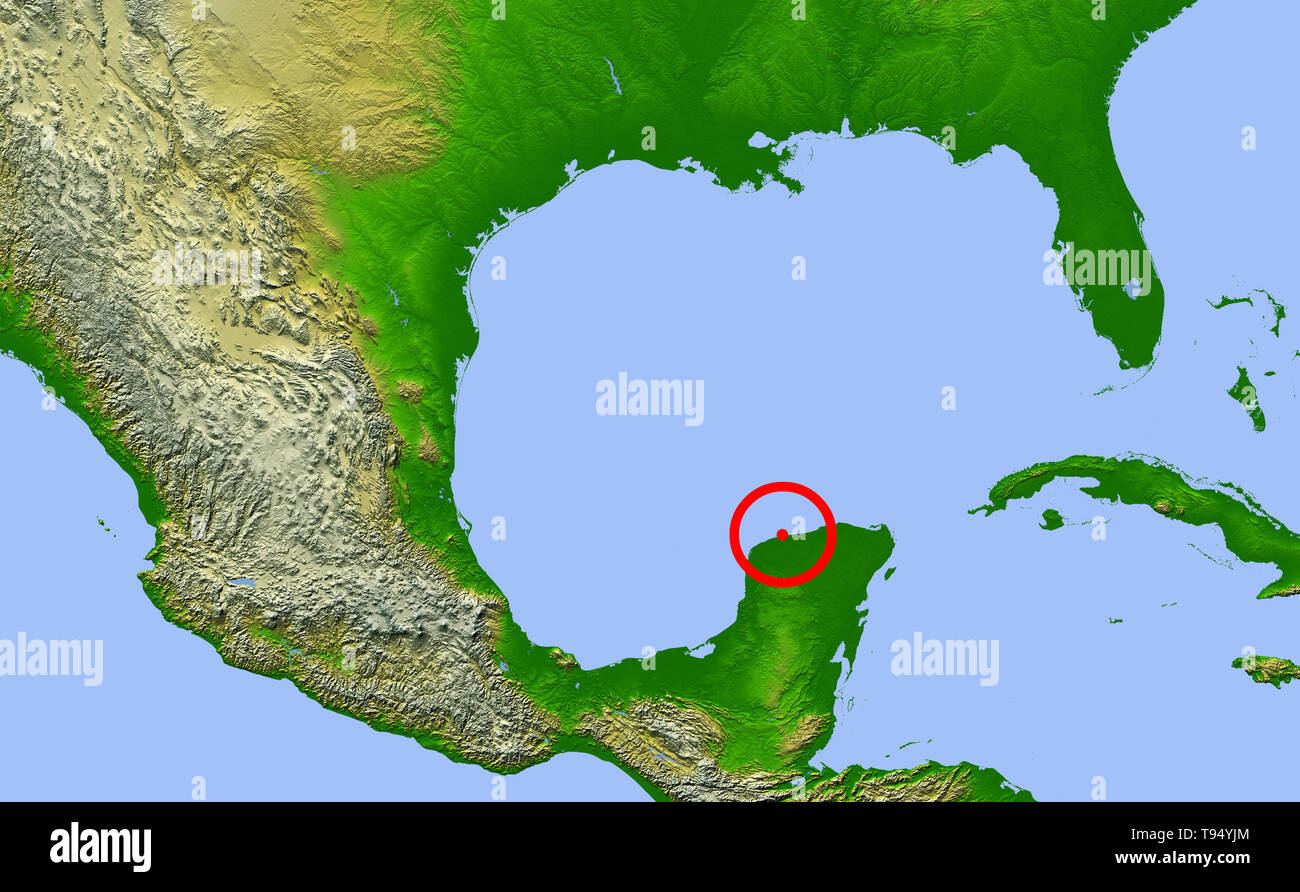 Chicxulub crater. Map showing the location of the Chicxulub impact crater (center) on the Yucatan Peninsula, Mexico. This impact may have caused the extinction of the dinosaurs and 70% of all Earth's species 65 million years ago. The four red dots represent the cities of (from left to right): Mexico City, Tempico (where material ejected from the crater has been found), Havana and Miami. Stock Photohttps://www.alamy.com/image-license-details/?v=1https://www.alamy.com/chicxulub-crater-map-showing-the-location-of-the-chicxulub-impact-crater-center-on-the-yucatan-peninsula-mexico-this-impact-may-have-caused-the-extinction-of-the-dinosaurs-and-70-of-all-earths-species-65-million-years-ago-the-four-red-dots-represent-the-cities-of-from-left-to-right-mexico-city-tempico-where-material-ejected-from-the-crater-has-been-found-havana-and-miami-image246586556.html
Chicxulub crater. Map showing the location of the Chicxulub impact crater (center) on the Yucatan Peninsula, Mexico. This impact may have caused the extinction of the dinosaurs and 70% of all Earth's species 65 million years ago. The four red dots represent the cities of (from left to right): Mexico City, Tempico (where material ejected from the crater has been found), Havana and Miami. Stock Photohttps://www.alamy.com/image-license-details/?v=1https://www.alamy.com/chicxulub-crater-map-showing-the-location-of-the-chicxulub-impact-crater-center-on-the-yucatan-peninsula-mexico-this-impact-may-have-caused-the-extinction-of-the-dinosaurs-and-70-of-all-earths-species-65-million-years-ago-the-four-red-dots-represent-the-cities-of-from-left-to-right-mexico-city-tempico-where-material-ejected-from-the-crater-has-been-found-havana-and-miami-image246586556.htmlRMT94YJM–Chicxulub crater. Map showing the location of the Chicxulub impact crater (center) on the Yucatan Peninsula, Mexico. This impact may have caused the extinction of the dinosaurs and 70% of all Earth's species 65 million years ago. The four red dots represent the cities of (from left to right): Mexico City, Tempico (where material ejected from the crater has been found), Havana and Miami.
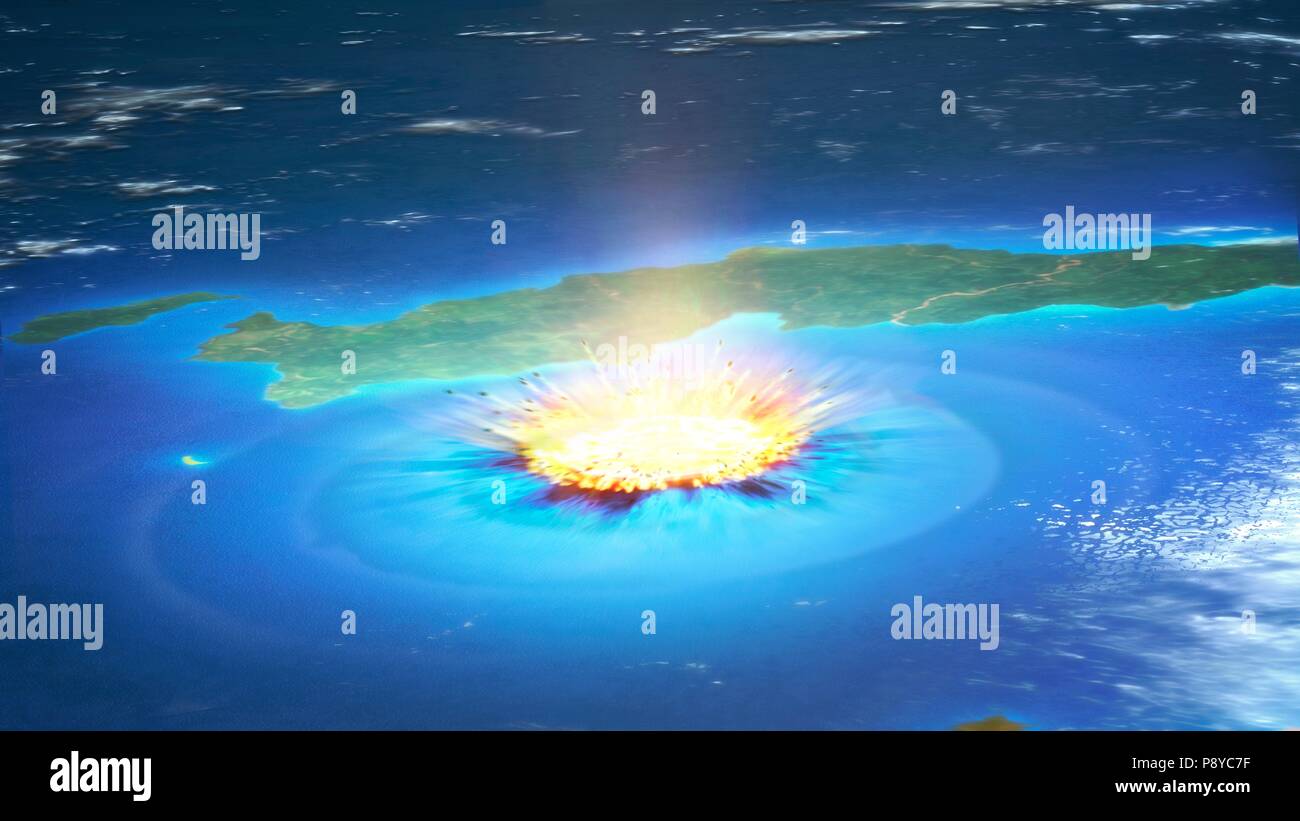 Asteroid impact. Illustration of a large asteroid colliding with Earth on the Yucatan Peninsula in Mexico. This impact is believed to have led to the death of the dinosaurs some 65 million years ago. The impact formed the Chicxulub crater, which is around 200 kilometres wide. The impact would have thrown trillions of tons of dust into the atmosphere, cooling the Earth's climate significantly, which may have been responsible for the mass extinction. A layer of iridium- rich rock, known as the K/pg boundary, is thought to be the remnants of the impact debris. Stock Photohttps://www.alamy.com/image-license-details/?v=1https://www.alamy.com/asteroid-impact-illustration-of-a-large-asteroid-colliding-with-earth-on-the-yucatan-peninsula-in-mexico-this-impact-is-believed-to-have-led-to-the-death-of-the-dinosaurs-some-65-million-years-ago-the-impact-formed-the-chicxulub-crater-which-is-around-200-kilometres-wide-the-impact-would-have-thrown-trillions-of-tons-of-dust-into-the-atmosphere-cooling-the-earths-climate-significantly-which-may-have-been-responsible-for-the-mass-extinction-a-layer-of-iridium-rich-rock-known-as-the-kpg-boundary-is-thought-to-be-the-remnants-of-the-impact-debris-image212043987.html
Asteroid impact. Illustration of a large asteroid colliding with Earth on the Yucatan Peninsula in Mexico. This impact is believed to have led to the death of the dinosaurs some 65 million years ago. The impact formed the Chicxulub crater, which is around 200 kilometres wide. The impact would have thrown trillions of tons of dust into the atmosphere, cooling the Earth's climate significantly, which may have been responsible for the mass extinction. A layer of iridium- rich rock, known as the K/pg boundary, is thought to be the remnants of the impact debris. Stock Photohttps://www.alamy.com/image-license-details/?v=1https://www.alamy.com/asteroid-impact-illustration-of-a-large-asteroid-colliding-with-earth-on-the-yucatan-peninsula-in-mexico-this-impact-is-believed-to-have-led-to-the-death-of-the-dinosaurs-some-65-million-years-ago-the-impact-formed-the-chicxulub-crater-which-is-around-200-kilometres-wide-the-impact-would-have-thrown-trillions-of-tons-of-dust-into-the-atmosphere-cooling-the-earths-climate-significantly-which-may-have-been-responsible-for-the-mass-extinction-a-layer-of-iridium-rich-rock-known-as-the-kpg-boundary-is-thought-to-be-the-remnants-of-the-impact-debris-image212043987.htmlRFP8YC7F–Asteroid impact. Illustration of a large asteroid colliding with Earth on the Yucatan Peninsula in Mexico. This impact is believed to have led to the death of the dinosaurs some 65 million years ago. The impact formed the Chicxulub crater, which is around 200 kilometres wide. The impact would have thrown trillions of tons of dust into the atmosphere, cooling the Earth's climate significantly, which may have been responsible for the mass extinction. A layer of iridium- rich rock, known as the K/pg boundary, is thought to be the remnants of the impact debris.
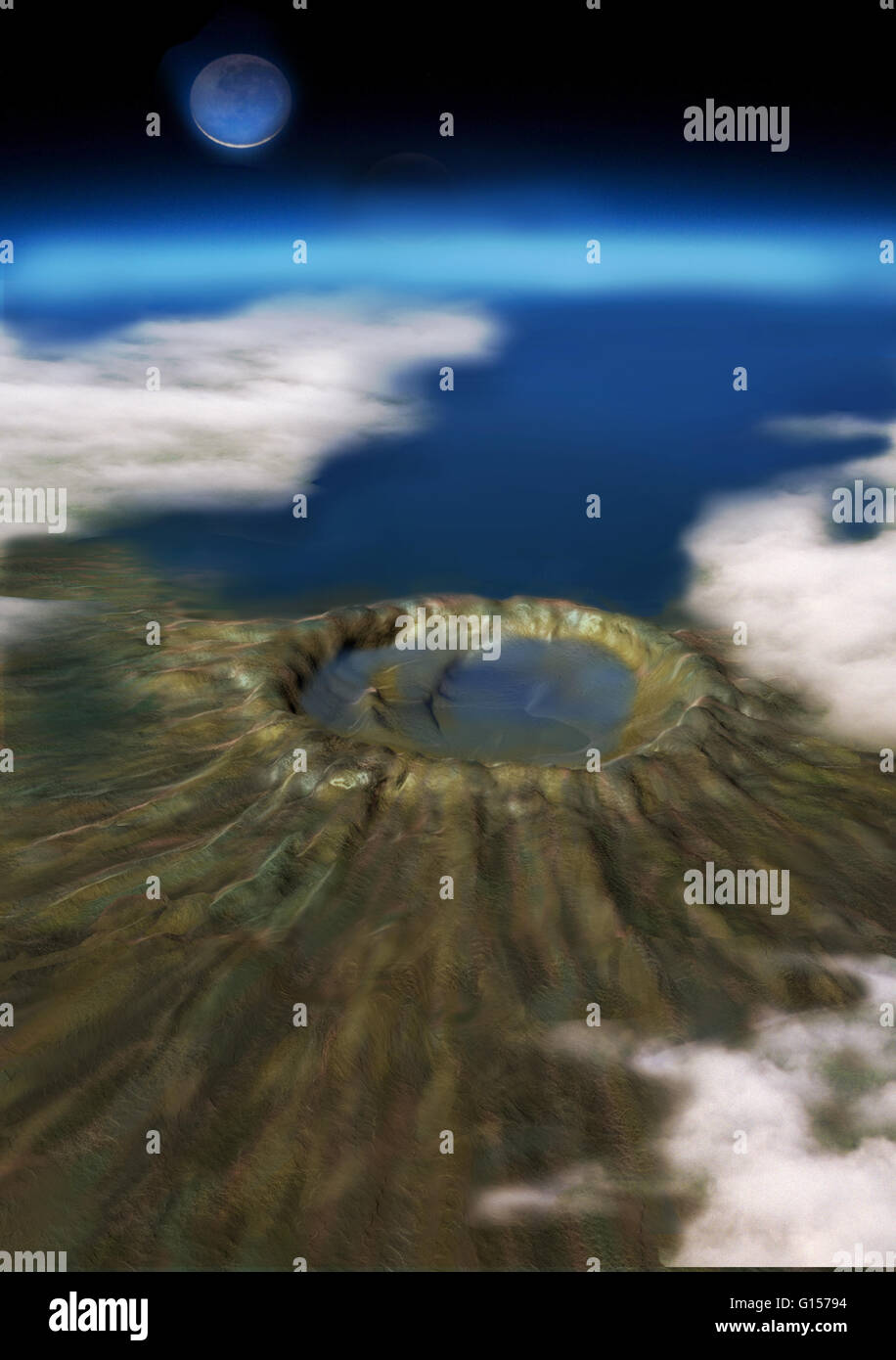 Illustrated representation of chicxulub crater. An asteroid impact at Chicxulub on the Yucatan Peninsula, Mexico, may have caused the extinction of the dinosaurs and 70% of all Earth's species 65 million years ago. The impact was caused by an asteroid or Stock Photohttps://www.alamy.com/image-license-details/?v=1https://www.alamy.com/stock-photo-illustrated-representation-of-chicxulub-crater-an-asteroid-impact-103992368.html
Illustrated representation of chicxulub crater. An asteroid impact at Chicxulub on the Yucatan Peninsula, Mexico, may have caused the extinction of the dinosaurs and 70% of all Earth's species 65 million years ago. The impact was caused by an asteroid or Stock Photohttps://www.alamy.com/image-license-details/?v=1https://www.alamy.com/stock-photo-illustrated-representation-of-chicxulub-crater-an-asteroid-impact-103992368.htmlRMG15794–Illustrated representation of chicxulub crater. An asteroid impact at Chicxulub on the Yucatan Peninsula, Mexico, may have caused the extinction of the dinosaurs and 70% of all Earth's species 65 million years ago. The impact was caused by an asteroid or
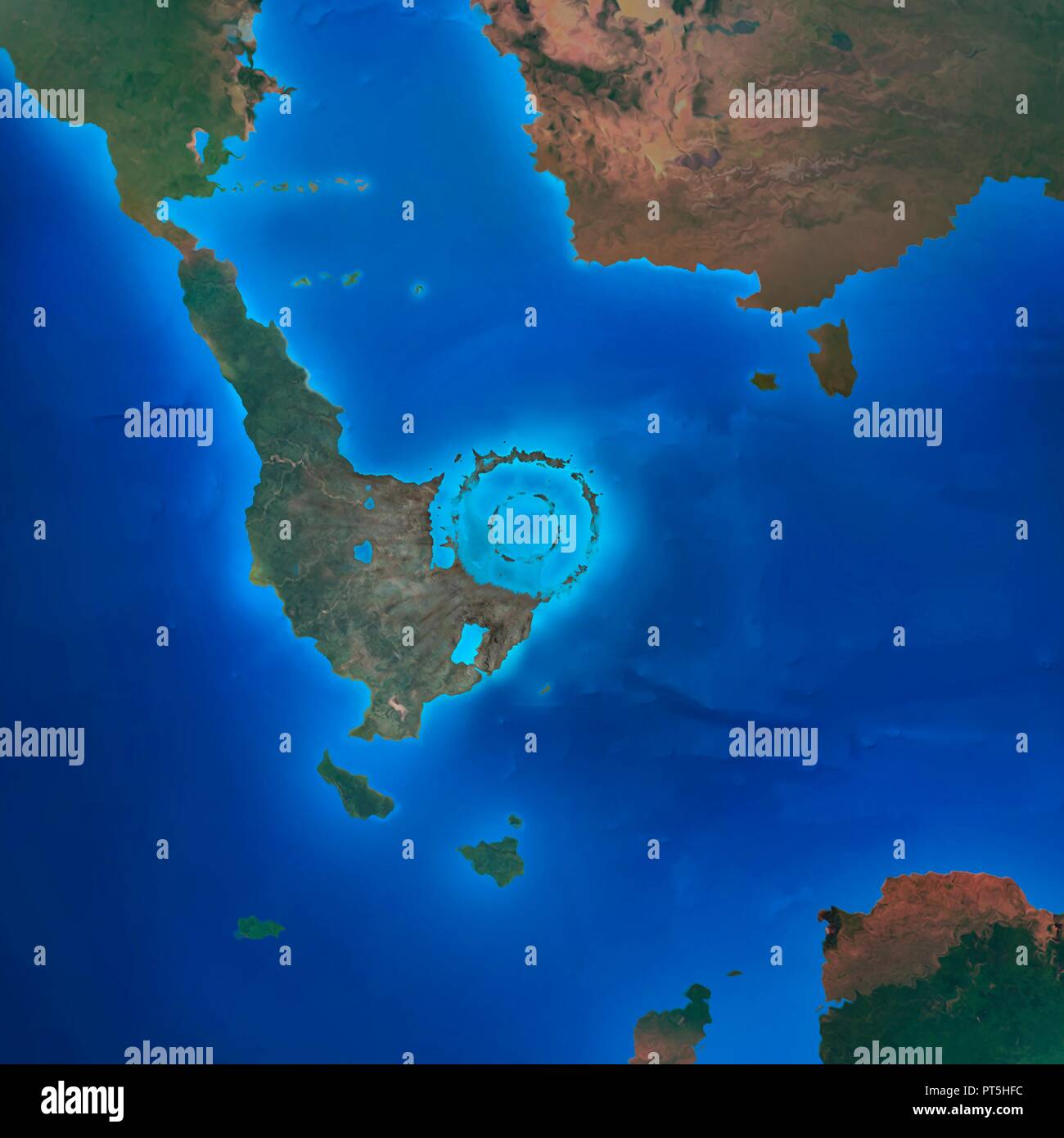 Illustration of the Chicxulub crater, shortly after its formation. This crater was formed 66 million years ago, off the coast of present-day Mexico, following the impact of an asteroid 10-14 kilometres across. The asteroid is widely believed to have provoked the extinction of the dinosaurs and other species at this time. The crater measures some 150 kilometres in diameter. Since its formation it has been buried in silt and covered by the sea, and is now only detectable using gravity measurements of the immediate area. Stock Photohttps://www.alamy.com/image-license-details/?v=1https://www.alamy.com/illustration-of-the-chicxulub-crater-shortly-after-its-formation-this-crater-was-formed-66-million-years-ago-off-the-coast-of-present-day-mexico-following-the-impact-of-an-asteroid-10-14-kilometres-across-the-asteroid-is-widely-believed-to-have-provoked-the-extinction-of-the-dinosaurs-and-other-species-at-this-time-the-crater-measures-some-150-kilometres-in-diameter-since-its-formation-it-has-been-buried-in-silt-and-covered-by-the-sea-and-is-now-only-detectable-using-gravity-measurements-of-the-immediate-area-image221399680.html
Illustration of the Chicxulub crater, shortly after its formation. This crater was formed 66 million years ago, off the coast of present-day Mexico, following the impact of an asteroid 10-14 kilometres across. The asteroid is widely believed to have provoked the extinction of the dinosaurs and other species at this time. The crater measures some 150 kilometres in diameter. Since its formation it has been buried in silt and covered by the sea, and is now only detectable using gravity measurements of the immediate area. Stock Photohttps://www.alamy.com/image-license-details/?v=1https://www.alamy.com/illustration-of-the-chicxulub-crater-shortly-after-its-formation-this-crater-was-formed-66-million-years-ago-off-the-coast-of-present-day-mexico-following-the-impact-of-an-asteroid-10-14-kilometres-across-the-asteroid-is-widely-believed-to-have-provoked-the-extinction-of-the-dinosaurs-and-other-species-at-this-time-the-crater-measures-some-150-kilometres-in-diameter-since-its-formation-it-has-been-buried-in-silt-and-covered-by-the-sea-and-is-now-only-detectable-using-gravity-measurements-of-the-immediate-area-image221399680.htmlRFPT5HFC–Illustration of the Chicxulub crater, shortly after its formation. This crater was formed 66 million years ago, off the coast of present-day Mexico, following the impact of an asteroid 10-14 kilometres across. The asteroid is widely believed to have provoked the extinction of the dinosaurs and other species at this time. The crater measures some 150 kilometres in diameter. Since its formation it has been buried in silt and covered by the sea, and is now only detectable using gravity measurements of the immediate area.
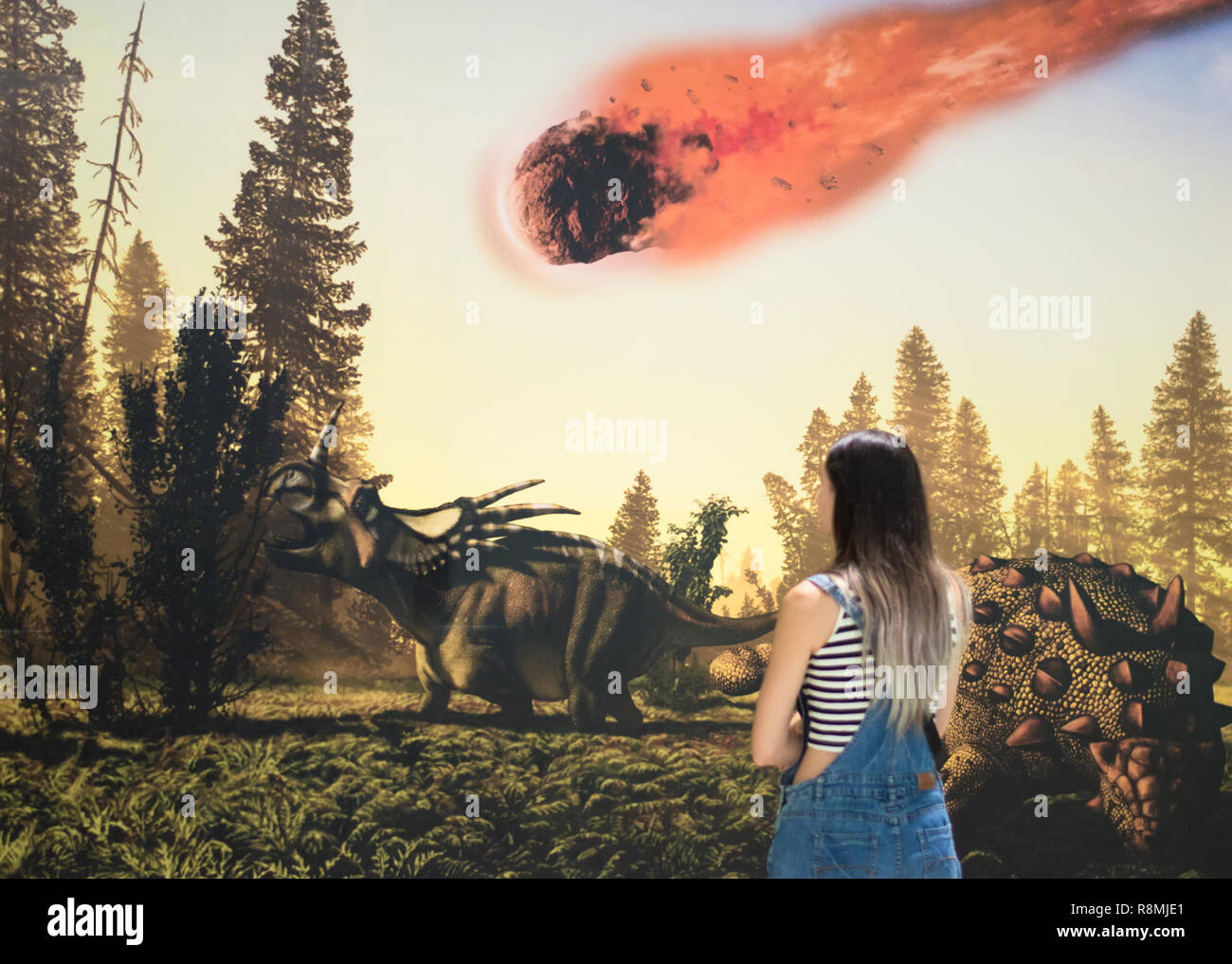 Mural at the Museo de Ciencias del Crater in Yucatan, depicting the asteroid which impacted into Chicxulub, leading to the extinction of dinosaurs. Stock Photohttps://www.alamy.com/image-license-details/?v=1https://www.alamy.com/mural-at-the-museo-de-ciencias-del-crater-in-yucatan-depicting-the-asteroid-which-impacted-into-chicxulub-leading-to-the-extinction-of-dinosaurs-image229105577.html
Mural at the Museo de Ciencias del Crater in Yucatan, depicting the asteroid which impacted into Chicxulub, leading to the extinction of dinosaurs. Stock Photohttps://www.alamy.com/image-license-details/?v=1https://www.alamy.com/mural-at-the-museo-de-ciencias-del-crater-in-yucatan-depicting-the-asteroid-which-impacted-into-chicxulub-leading-to-the-extinction-of-dinosaurs-image229105577.htmlRFR8MJE1–Mural at the Museo de Ciencias del Crater in Yucatan, depicting the asteroid which impacted into Chicxulub, leading to the extinction of dinosaurs.
 Drilling program sign marking the site of the Chicxulub Crater in Yucatan, Mexico Stock Photohttps://www.alamy.com/image-license-details/?v=1https://www.alamy.com/stock-photo-drilling-program-sign-marking-the-site-of-the-chicxulub-crater-in-144917141.html
Drilling program sign marking the site of the Chicxulub Crater in Yucatan, Mexico Stock Photohttps://www.alamy.com/image-license-details/?v=1https://www.alamy.com/stock-photo-drilling-program-sign-marking-the-site-of-the-chicxulub-crater-in-144917141.htmlRMJBNF85–Drilling program sign marking the site of the Chicxulub Crater in Yucatan, Mexico
 Satellite image of Chicxulub crater on the Yucatan Peninsula in Mexico. Stock Photohttps://www.alamy.com/image-license-details/?v=1https://www.alamy.com/satellite-image-of-chicxulub-crater-on-the-yucatan-peninsula-in-mexico-image575102077.html
Satellite image of Chicxulub crater on the Yucatan Peninsula in Mexico. Stock Photohttps://www.alamy.com/image-license-details/?v=1https://www.alamy.com/satellite-image-of-chicxulub-crater-on-the-yucatan-peninsula-in-mexico-image575102077.htmlRF2TBJ4FW–Satellite image of Chicxulub crater on the Yucatan Peninsula in Mexico.
 Model of the Chicxulub Asteroid of which the impact resulted in the Cretaceous–Paleogene extinction event which caused the demise of the planet's non-avian dinosaurs and other species. Dated 21st Century Stock Photohttps://www.alamy.com/image-license-details/?v=1https://www.alamy.com/stock-photo-model-of-the-chicxulub-asteroid-of-which-the-impact-resulted-in-the-122926862.html
Model of the Chicxulub Asteroid of which the impact resulted in the Cretaceous–Paleogene extinction event which caused the demise of the planet's non-avian dinosaurs and other species. Dated 21st Century Stock Photohttps://www.alamy.com/image-license-details/?v=1https://www.alamy.com/stock-photo-model-of-the-chicxulub-asteroid-of-which-the-impact-resulted-in-the-122926862.htmlRMH3YPD2–Model of the Chicxulub Asteroid of which the impact resulted in the Cretaceous–Paleogene extinction event which caused the demise of the planet's non-avian dinosaurs and other species. Dated 21st Century
 Tyrannosaurus rex and pteranodons watch a meteorite impact in Yucatan, Mexico, that created Chicxulub crater and induced the end Stock Photohttps://www.alamy.com/image-license-details/?v=1https://www.alamy.com/stock-photo-tyrannosaurus-rex-and-pteranodons-watch-a-meteorite-impact-in-yucatan-72785025.html
Tyrannosaurus rex and pteranodons watch a meteorite impact in Yucatan, Mexico, that created Chicxulub crater and induced the end Stock Photohttps://www.alamy.com/image-license-details/?v=1https://www.alamy.com/stock-photo-tyrannosaurus-rex-and-pteranodons-watch-a-meteorite-impact-in-yucatan-72785025.htmlRFE6BJ15–Tyrannosaurus rex and pteranodons watch a meteorite impact in Yucatan, Mexico, that created Chicxulub crater and induced the end
 Cráter de Chicxulub Stock Photohttps://www.alamy.com/image-license-details/?v=1https://www.alamy.com/stock-image-crter-de-chicxulub-169339142.html
Cráter de Chicxulub Stock Photohttps://www.alamy.com/image-license-details/?v=1https://www.alamy.com/stock-image-crter-de-chicxulub-169339142.htmlRMKRE1PE–Cráter de Chicxulub
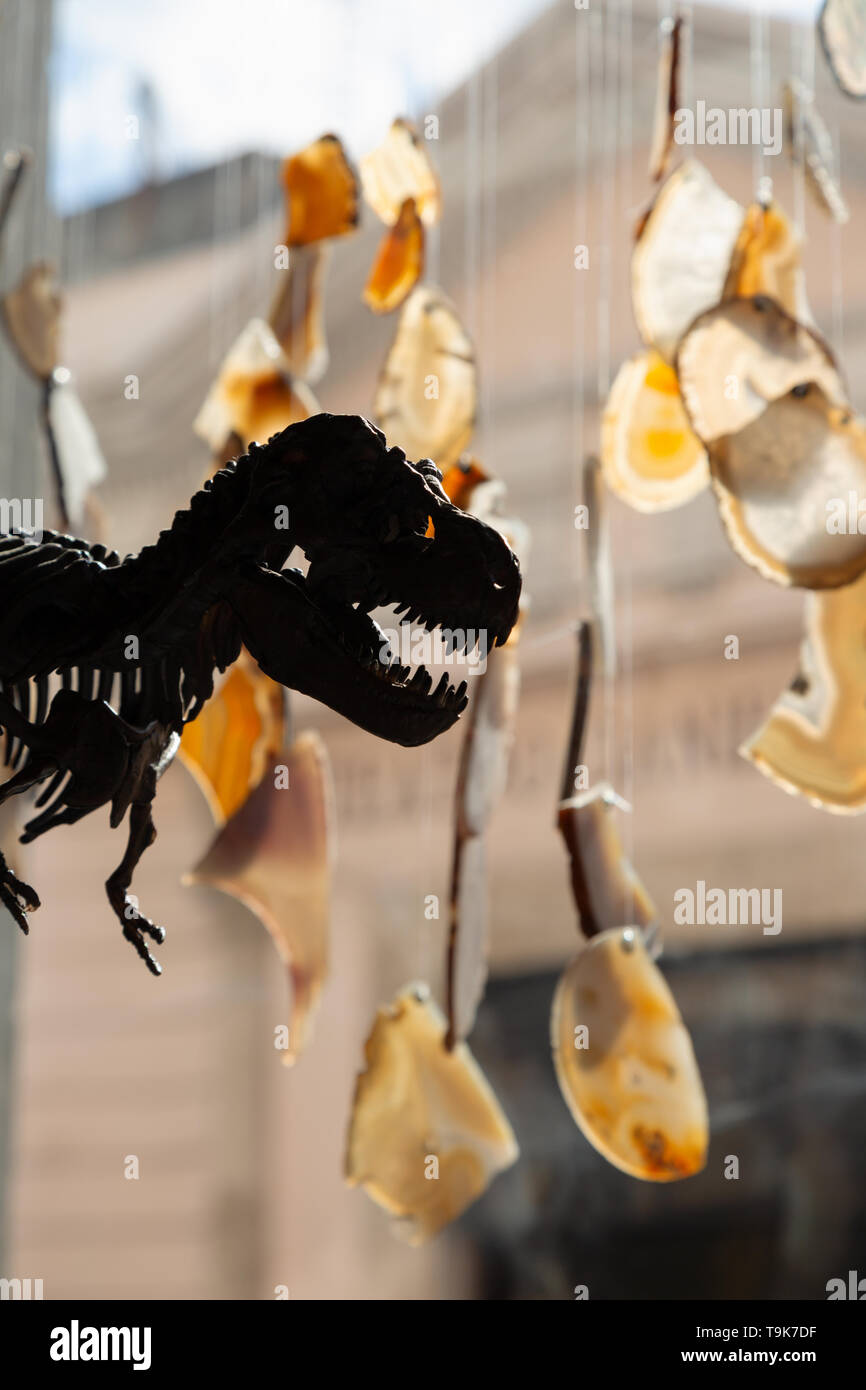 Model dinosaur in fossil shop, Merida city which lies in the Chicxulub crater, the meteor strike which ended the dinosaurs, Merida, Yucatan, Mexico Stock Photohttps://www.alamy.com/image-license-details/?v=1https://www.alamy.com/model-dinosaur-in-fossil-shop-merida-city-which-lies-in-the-chicxulub-crater-the-meteor-strike-which-ended-the-dinosaurs-merida-yucatan-mexico-image246900011.html
Model dinosaur in fossil shop, Merida city which lies in the Chicxulub crater, the meteor strike which ended the dinosaurs, Merida, Yucatan, Mexico Stock Photohttps://www.alamy.com/image-license-details/?v=1https://www.alamy.com/model-dinosaur-in-fossil-shop-merida-city-which-lies-in-the-chicxulub-crater-the-meteor-strike-which-ended-the-dinosaurs-merida-yucatan-mexico-image246900011.htmlRMT9K7DF–Model dinosaur in fossil shop, Merida city which lies in the Chicxulub crater, the meteor strike which ended the dinosaurs, Merida, Yucatan, Mexico
 Tyrannosaurus rex and pteranodon looking at meteorite impact in Yucatan, Mexico, that created Chicxulub crater and induced end o Stock Photohttps://www.alamy.com/image-license-details/?v=1https://www.alamy.com/stock-photo-tyrannosaurus-rex-and-pteranodon-looking-at-meteorite-impact-in-yucatan-75927964.html
Tyrannosaurus rex and pteranodon looking at meteorite impact in Yucatan, Mexico, that created Chicxulub crater and induced end o Stock Photohttps://www.alamy.com/image-license-details/?v=1https://www.alamy.com/stock-photo-tyrannosaurus-rex-and-pteranodon-looking-at-meteorite-impact-in-yucatan-75927964.htmlRFEBEPW0–Tyrannosaurus rex and pteranodon looking at meteorite impact in Yucatan, Mexico, that created Chicxulub crater and induced end o
 People swimming in a cenote in Yucatan, Mexico Stock Photohttps://www.alamy.com/image-license-details/?v=1https://www.alamy.com/people-swimming-in-a-cenote-in-yucatan-mexico-image454287793.html
People swimming in a cenote in Yucatan, Mexico Stock Photohttps://www.alamy.com/image-license-details/?v=1https://www.alamy.com/people-swimming-in-a-cenote-in-yucatan-mexico-image454287793.htmlRM2HB2GM1–People swimming in a cenote in Yucatan, Mexico
 Near-Earth objects Stock Photohttps://www.alamy.com/image-license-details/?v=1https://www.alamy.com/stock-photo-near-earth-objects-25485508.html
Near-Earth objects Stock Photohttps://www.alamy.com/image-license-details/?v=1https://www.alamy.com/stock-photo-near-earth-objects-25485508.htmlRMBDCY0M–Near-Earth objects
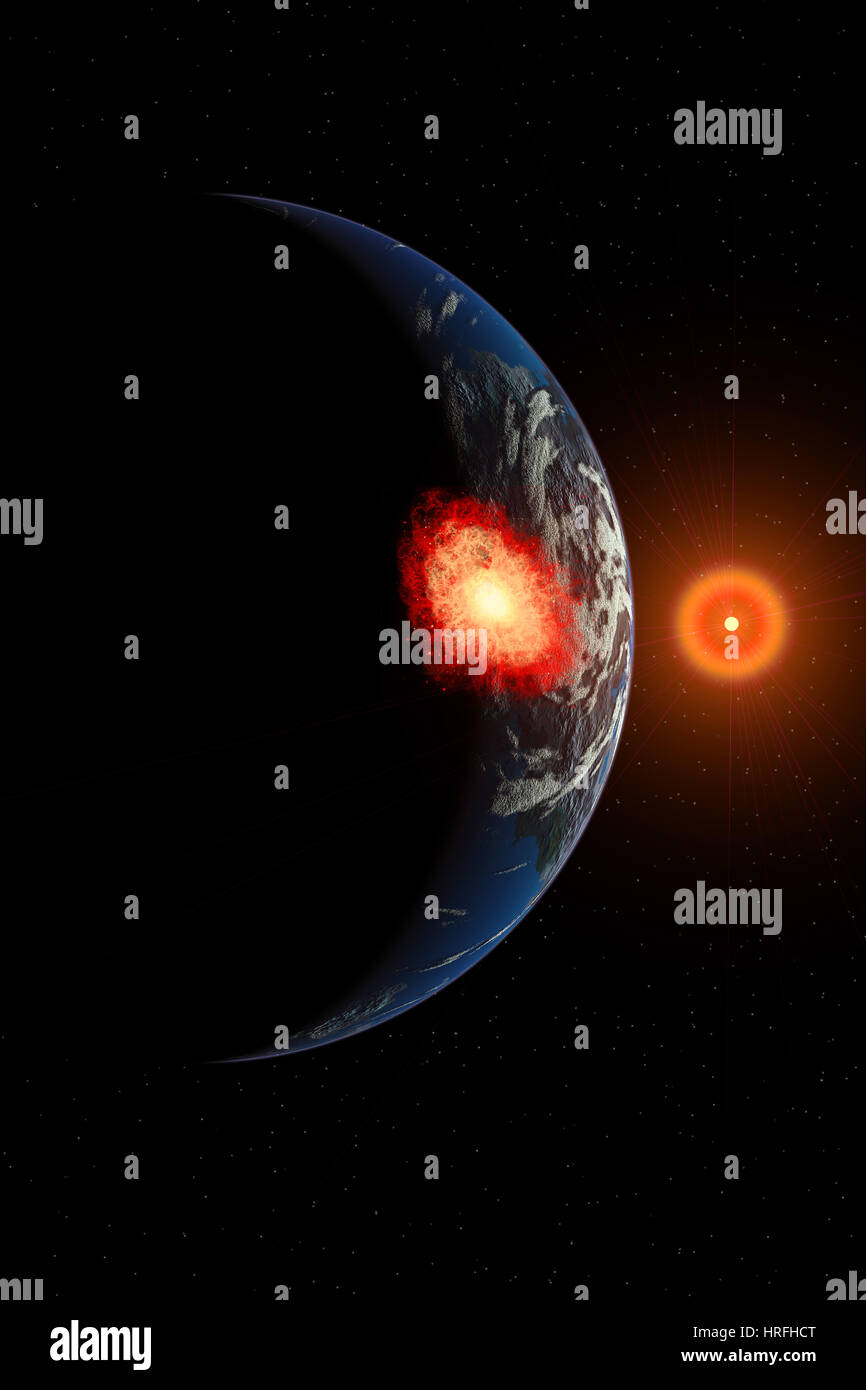 The Cretaceous Paleogene Extinction Event Stock Photohttps://www.alamy.com/image-license-details/?v=1https://www.alamy.com/stock-photo-the-cretaceous-paleogene-extinction-event-134952632.html
The Cretaceous Paleogene Extinction Event Stock Photohttps://www.alamy.com/image-license-details/?v=1https://www.alamy.com/stock-photo-the-cretaceous-paleogene-extinction-event-134952632.htmlRMHRFHCT–The Cretaceous Paleogene Extinction Event
 Tyrannosaurus rex and pteranodon looking at meteorite impact in Yucatan, Mexico, that created Chicxulub crater and induced end of dinosaurs - 3D render Stock Photohttps://www.alamy.com/image-license-details/?v=1https://www.alamy.com/stock-photo-tyrannosaurus-rex-and-pteranodon-looking-at-meteorite-impact-in-yucatan-145160128.html
Tyrannosaurus rex and pteranodon looking at meteorite impact in Yucatan, Mexico, that created Chicxulub crater and induced end of dinosaurs - 3D render Stock Photohttps://www.alamy.com/image-license-details/?v=1https://www.alamy.com/stock-photo-tyrannosaurus-rex-and-pteranodon-looking-at-meteorite-impact-in-yucatan-145160128.htmlRFJC4H68–Tyrannosaurus rex and pteranodon looking at meteorite impact in Yucatan, Mexico, that created Chicxulub crater and induced end of dinosaurs - 3D render
 K-T boundary (Cretaceous-Tertiary), Royal Tyrrell Dinosaur Museum, Drumheller, Alberta, Canada Stock Photohttps://www.alamy.com/image-license-details/?v=1https://www.alamy.com/stock-photo-k-t-boundary-cretaceous-tertiary-royal-tyrrell-dinosaur-museum-drumheller-31335205.html
K-T boundary (Cretaceous-Tertiary), Royal Tyrrell Dinosaur Museum, Drumheller, Alberta, Canada Stock Photohttps://www.alamy.com/image-license-details/?v=1https://www.alamy.com/stock-photo-k-t-boundary-cretaceous-tertiary-royal-tyrrell-dinosaur-museum-drumheller-31335205.htmlRMBPYCAD–K-T boundary (Cretaceous-Tertiary), Royal Tyrrell Dinosaur Museum, Drumheller, Alberta, Canada
![Infographics about the extinction of the dinosaurs that posits two hypotheses: the impact of a meteorite, or the impact of volcanic activity. [QuarkXPress (.qxp); 4842x3248]. Stock Photo Infographics about the extinction of the dinosaurs that posits two hypotheses: the impact of a meteorite, or the impact of volcanic activity. [QuarkXPress (.qxp); 4842x3248]. Stock Photo](https://c8.alamy.com/comp/2NEBWA1/infographics-about-the-extinction-of-the-dinosaurs-that-posits-two-hypotheses-the-impact-of-a-meteorite-or-the-impact-of-volcanic-activity-quarkxpress-qxp-4842x3248-2NEBWA1.jpg) Infographics about the extinction of the dinosaurs that posits two hypotheses: the impact of a meteorite, or the impact of volcanic activity. [QuarkXPress (.qxp); 4842x3248]. Stock Photohttps://www.alamy.com/image-license-details/?v=1https://www.alamy.com/infographics-about-the-extinction-of-the-dinosaurs-that-posits-two-hypotheses-the-impact-of-a-meteorite-or-the-impact-of-volcanic-activity-quarkxpress-qxp-4842x3248-image525177577.html
Infographics about the extinction of the dinosaurs that posits two hypotheses: the impact of a meteorite, or the impact of volcanic activity. [QuarkXPress (.qxp); 4842x3248]. Stock Photohttps://www.alamy.com/image-license-details/?v=1https://www.alamy.com/infographics-about-the-extinction-of-the-dinosaurs-that-posits-two-hypotheses-the-impact-of-a-meteorite-or-the-impact-of-volcanic-activity-quarkxpress-qxp-4842x3248-image525177577.htmlRM2NEBWA1–Infographics about the extinction of the dinosaurs that posits two hypotheses: the impact of a meteorite, or the impact of volcanic activity. [QuarkXPress (.qxp); 4842x3248].
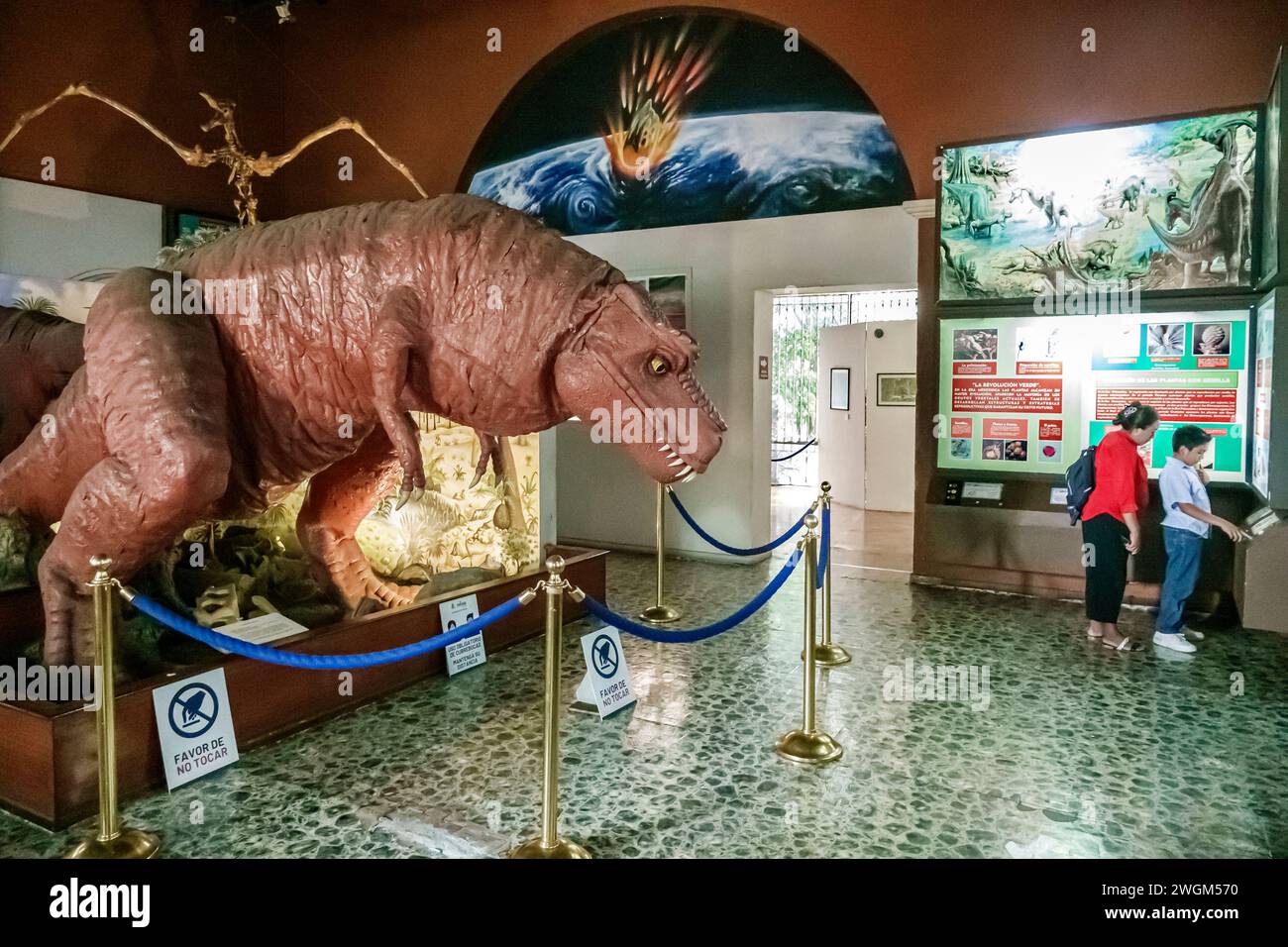 Merida Mexico,Centro,Museo de Historia Natural history museum,inside interior,exhibit exhibits display displays collection,collections gallery galleri Stock Photohttps://www.alamy.com/image-license-details/?v=1https://www.alamy.com/merida-mexicocentromuseo-de-historia-natural-history-museuminside-interiorexhibit-exhibits-display-displays-collectioncollections-gallery-galleri-image595430164.html
Merida Mexico,Centro,Museo de Historia Natural history museum,inside interior,exhibit exhibits display displays collection,collections gallery galleri Stock Photohttps://www.alamy.com/image-license-details/?v=1https://www.alamy.com/merida-mexicocentromuseo-de-historia-natural-history-museuminside-interiorexhibit-exhibits-display-displays-collectioncollections-gallery-galleri-image595430164.htmlRM2WGM570–Merida Mexico,Centro,Museo de Historia Natural history museum,inside interior,exhibit exhibits display displays collection,collections gallery galleri
 End of dinosaurs due to meteorite impact in Yucatan, Mexico - 3D render Stock Photohttps://www.alamy.com/image-license-details/?v=1https://www.alamy.com/stock-photo-end-of-dinosaurs-due-to-meteorite-impact-in-yucatan-mexico-3d-render-103052615.html
End of dinosaurs due to meteorite impact in Yucatan, Mexico - 3D render Stock Photohttps://www.alamy.com/image-license-details/?v=1https://www.alamy.com/stock-photo-end-of-dinosaurs-due-to-meteorite-impact-in-yucatan-mexico-3d-render-103052615.htmlRMFYJCJF–End of dinosaurs due to meteorite impact in Yucatan, Mexico - 3D render
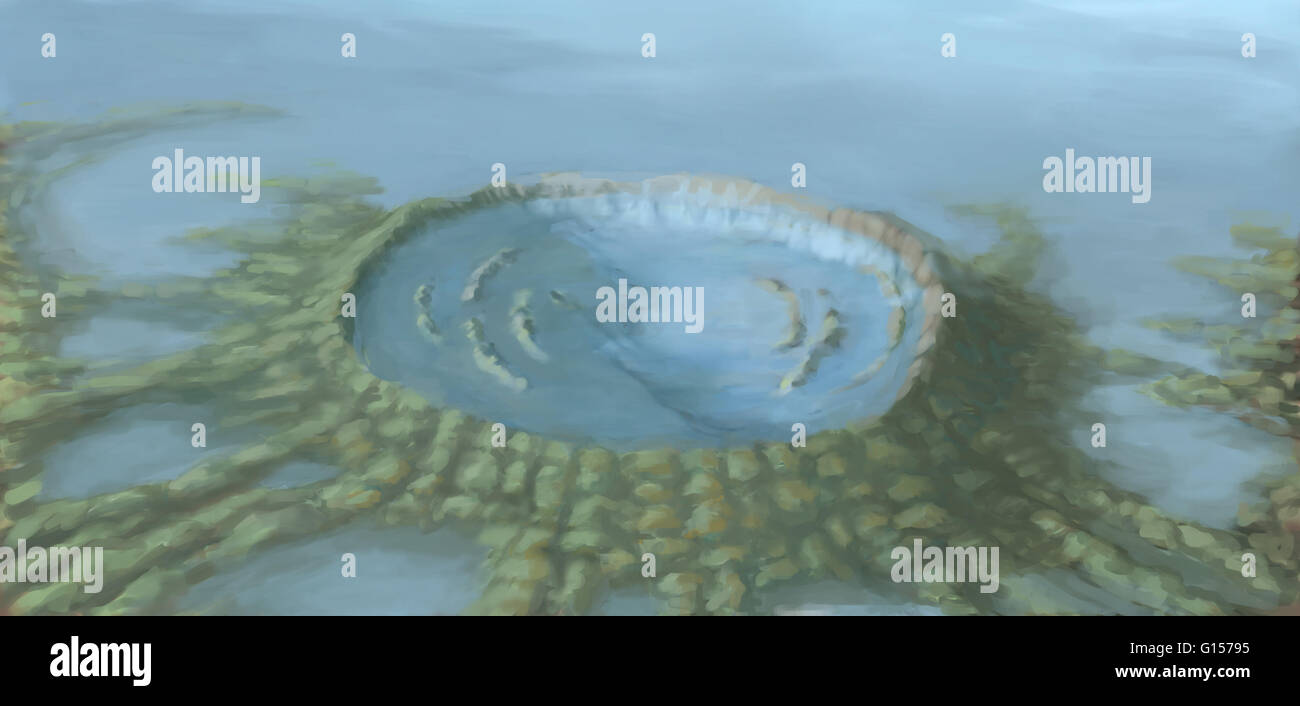 Illustrated representation of chicxulub crater. An asteroid impact at Chicxulub on the Yucatan Peninsula, Mexico, may have caused the extinction of the dinosaurs and 70% of all Earth's species 65 million years ago. The impact was caused by an asteroid or Stock Photohttps://www.alamy.com/image-license-details/?v=1https://www.alamy.com/stock-photo-illustrated-representation-of-chicxulub-crater-an-asteroid-impact-103992369.html
Illustrated representation of chicxulub crater. An asteroid impact at Chicxulub on the Yucatan Peninsula, Mexico, may have caused the extinction of the dinosaurs and 70% of all Earth's species 65 million years ago. The impact was caused by an asteroid or Stock Photohttps://www.alamy.com/image-license-details/?v=1https://www.alamy.com/stock-photo-illustrated-representation-of-chicxulub-crater-an-asteroid-impact-103992369.htmlRMG15795–Illustrated representation of chicxulub crater. An asteroid impact at Chicxulub on the Yucatan Peninsula, Mexico, may have caused the extinction of the dinosaurs and 70% of all Earth's species 65 million years ago. The impact was caused by an asteroid or
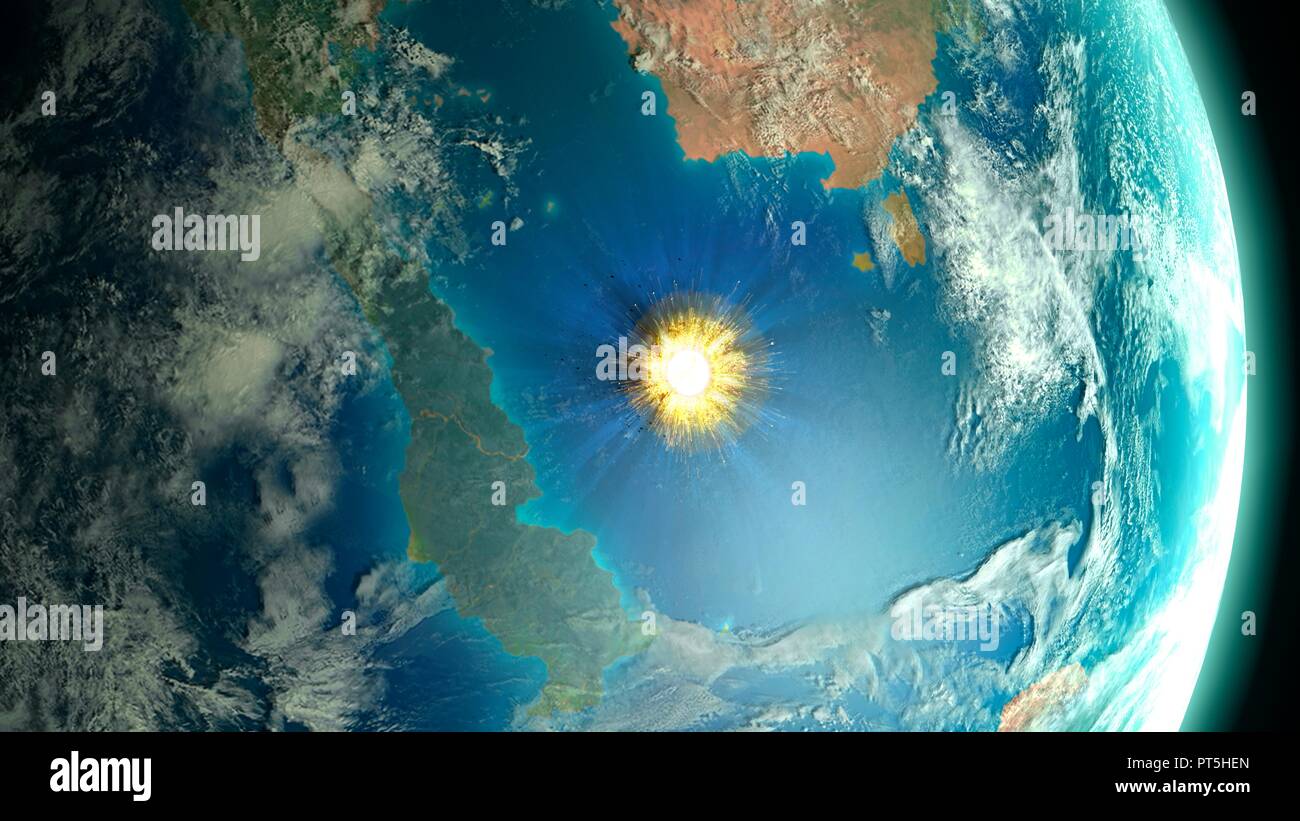 Asteroid impact. Illustration of a large asteroid colliding with Earth on the Yucatan Peninsula in Mexico. This impact is believed to have led to the death of the dinosaurs some 65 million years ago. The impact formed the Chicxulub crater, which is around 200 kilometres wide. The impact would have thrown trillions of tons of dust into the atmosphere, cooling the Earth's climate significantly, which may have been responsible for the mass extinction. A layer of iridium-rich rock, known as the K-pg boundary, is thought to be the remnants of the impact debris. Stock Photohttps://www.alamy.com/image-license-details/?v=1https://www.alamy.com/asteroid-impact-illustration-of-a-large-asteroid-colliding-with-earth-on-the-yucatan-peninsula-in-mexico-this-impact-is-believed-to-have-led-to-the-death-of-the-dinosaurs-some-65-million-years-ago-the-impact-formed-the-chicxulub-crater-which-is-around-200-kilometres-wide-the-impact-would-have-thrown-trillions-of-tons-of-dust-into-the-atmosphere-cooling-the-earths-climate-significantly-which-may-have-been-responsible-for-the-mass-extinction-a-layer-of-iridium-rich-rock-known-as-the-k-pg-boundary-is-thought-to-be-the-remnants-of-the-impact-debris-image221399661.html
Asteroid impact. Illustration of a large asteroid colliding with Earth on the Yucatan Peninsula in Mexico. This impact is believed to have led to the death of the dinosaurs some 65 million years ago. The impact formed the Chicxulub crater, which is around 200 kilometres wide. The impact would have thrown trillions of tons of dust into the atmosphere, cooling the Earth's climate significantly, which may have been responsible for the mass extinction. A layer of iridium-rich rock, known as the K-pg boundary, is thought to be the remnants of the impact debris. Stock Photohttps://www.alamy.com/image-license-details/?v=1https://www.alamy.com/asteroid-impact-illustration-of-a-large-asteroid-colliding-with-earth-on-the-yucatan-peninsula-in-mexico-this-impact-is-believed-to-have-led-to-the-death-of-the-dinosaurs-some-65-million-years-ago-the-impact-formed-the-chicxulub-crater-which-is-around-200-kilometres-wide-the-impact-would-have-thrown-trillions-of-tons-of-dust-into-the-atmosphere-cooling-the-earths-climate-significantly-which-may-have-been-responsible-for-the-mass-extinction-a-layer-of-iridium-rich-rock-known-as-the-k-pg-boundary-is-thought-to-be-the-remnants-of-the-impact-debris-image221399661.htmlRFPT5HEN–Asteroid impact. Illustration of a large asteroid colliding with Earth on the Yucatan Peninsula in Mexico. This impact is believed to have led to the death of the dinosaurs some 65 million years ago. The impact formed the Chicxulub crater, which is around 200 kilometres wide. The impact would have thrown trillions of tons of dust into the atmosphere, cooling the Earth's climate significantly, which may have been responsible for the mass extinction. A layer of iridium-rich rock, known as the K-pg boundary, is thought to be the remnants of the impact debris.
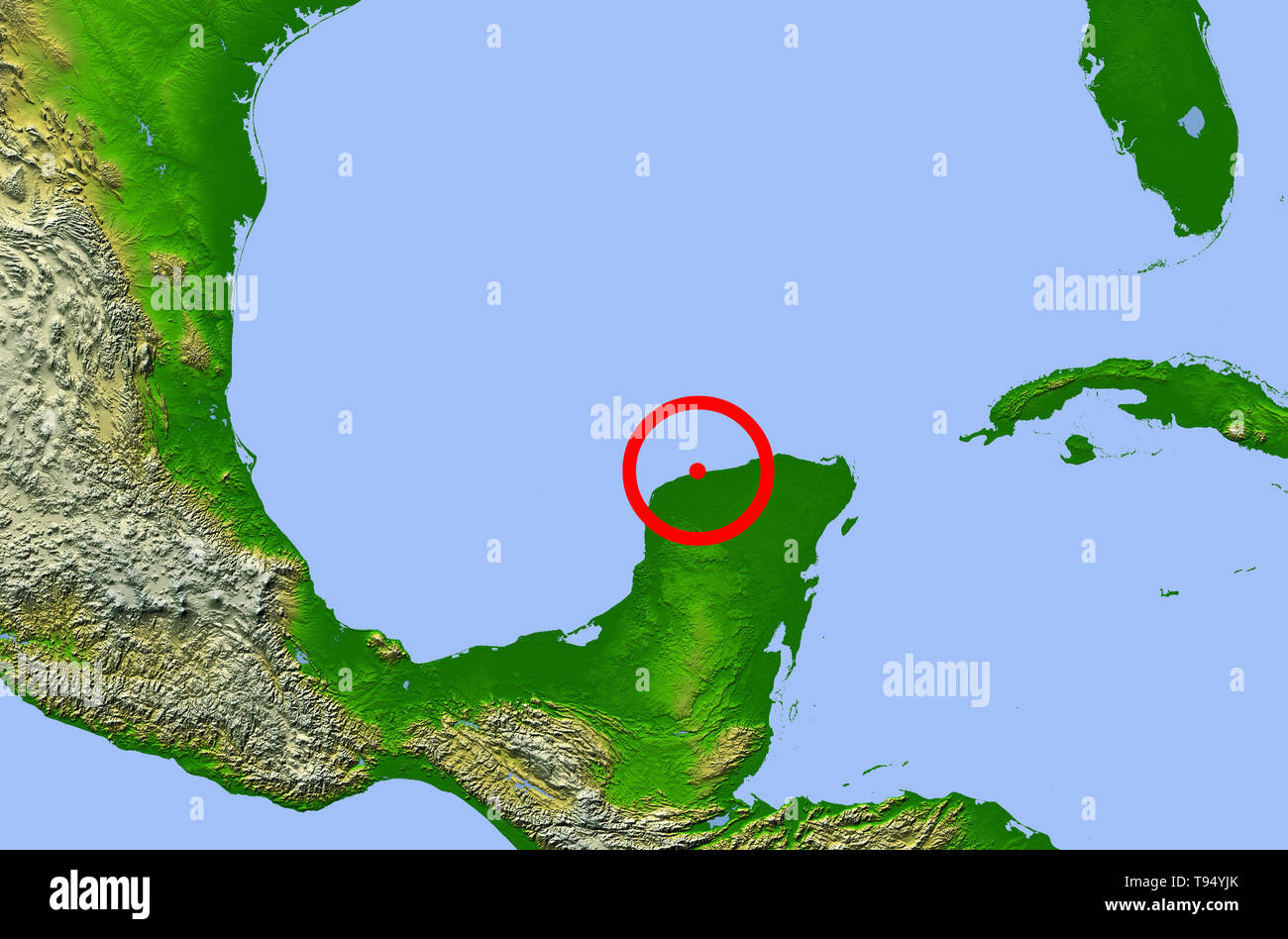 Chicxulub crater. Map showing the location of the Chicxulub impact crater (center) on the Yucatan Peninsula, Mexico. This impact may have caused the extinction of the dinosaurs and 70% of all Earth's species 65 million years ago. The four red dots represent the cities of (from left to right): Mexico City, Tempico (where material ejected from the crater has been found), Havana and Miami. Stock Photohttps://www.alamy.com/image-license-details/?v=1https://www.alamy.com/chicxulub-crater-map-showing-the-location-of-the-chicxulub-impact-crater-center-on-the-yucatan-peninsula-mexico-this-impact-may-have-caused-the-extinction-of-the-dinosaurs-and-70-of-all-earths-species-65-million-years-ago-the-four-red-dots-represent-the-cities-of-from-left-to-right-mexico-city-tempico-where-material-ejected-from-the-crater-has-been-found-havana-and-miami-image246586555.html
Chicxulub crater. Map showing the location of the Chicxulub impact crater (center) on the Yucatan Peninsula, Mexico. This impact may have caused the extinction of the dinosaurs and 70% of all Earth's species 65 million years ago. The four red dots represent the cities of (from left to right): Mexico City, Tempico (where material ejected from the crater has been found), Havana and Miami. Stock Photohttps://www.alamy.com/image-license-details/?v=1https://www.alamy.com/chicxulub-crater-map-showing-the-location-of-the-chicxulub-impact-crater-center-on-the-yucatan-peninsula-mexico-this-impact-may-have-caused-the-extinction-of-the-dinosaurs-and-70-of-all-earths-species-65-million-years-ago-the-four-red-dots-represent-the-cities-of-from-left-to-right-mexico-city-tempico-where-material-ejected-from-the-crater-has-been-found-havana-and-miami-image246586555.htmlRMT94YJK–Chicxulub crater. Map showing the location of the Chicxulub impact crater (center) on the Yucatan Peninsula, Mexico. This impact may have caused the extinction of the dinosaurs and 70% of all Earth's species 65 million years ago. The four red dots represent the cities of (from left to right): Mexico City, Tempico (where material ejected from the crater has been found), Havana and Miami.
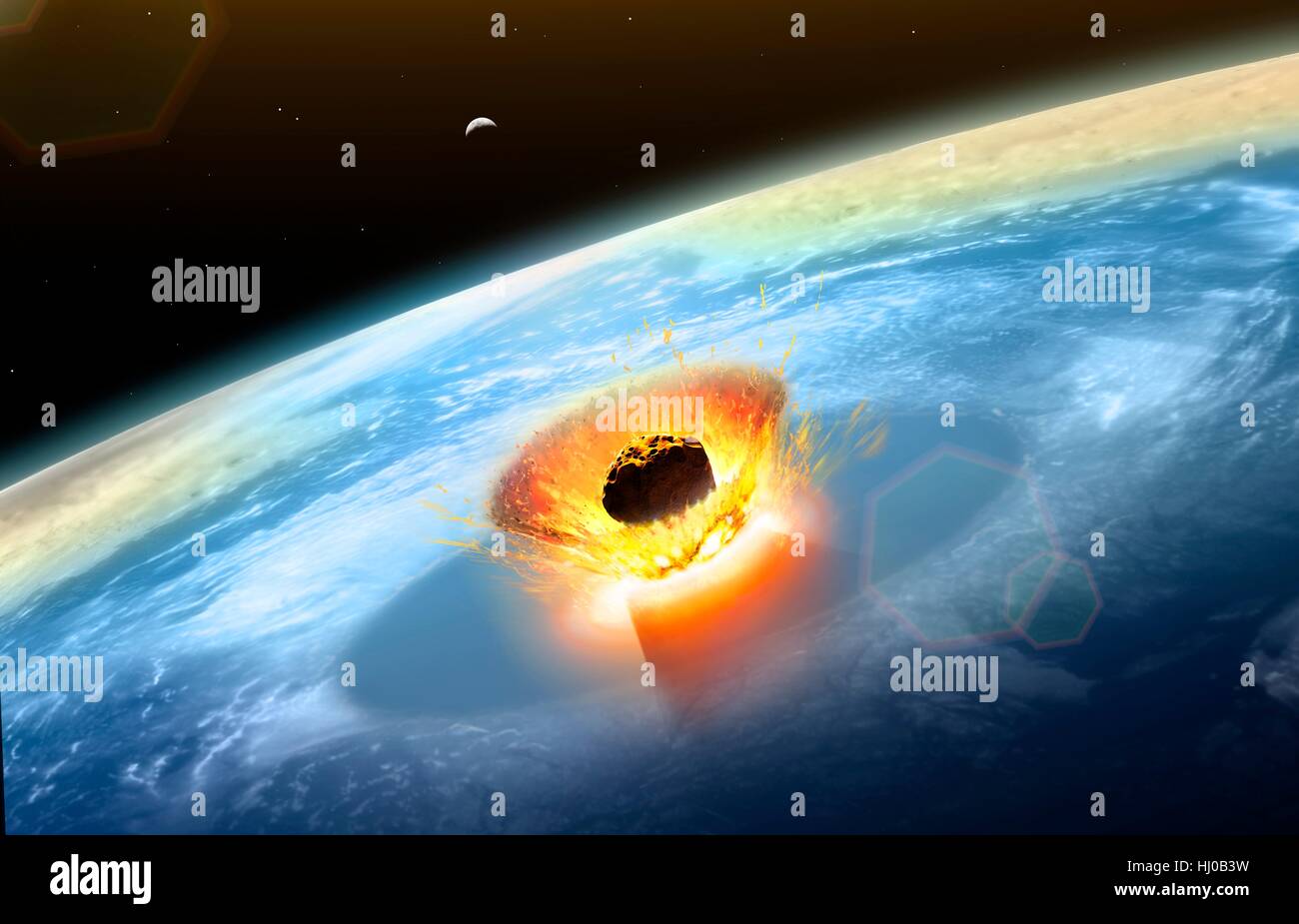 Asteroid impact. Illustration of a large asteroid colliding with Earth on the Yucatan Peninsula in (what is modern day) Mexico. This impact is believed to have led to the death of the dinosaurs some 65 million years ago. The impact formed the Chicxulub crater, which is around 200 kilometres wide. The impact would have thrown trillions of tons of dust into the atmosphere, cooling the Earth's climate significantly, which may have been responsible for the mass extinction. A layer of iridium- rich rock, known as the K pg boundary, is thought to be the remnants of the impact debris. Stock Photohttps://www.alamy.com/image-license-details/?v=1https://www.alamy.com/stock-photo-asteroid-impact-illustration-of-a-large-asteroid-colliding-with-earth-131545117.html
Asteroid impact. Illustration of a large asteroid colliding with Earth on the Yucatan Peninsula in (what is modern day) Mexico. This impact is believed to have led to the death of the dinosaurs some 65 million years ago. The impact formed the Chicxulub crater, which is around 200 kilometres wide. The impact would have thrown trillions of tons of dust into the atmosphere, cooling the Earth's climate significantly, which may have been responsible for the mass extinction. A layer of iridium- rich rock, known as the K pg boundary, is thought to be the remnants of the impact debris. Stock Photohttps://www.alamy.com/image-license-details/?v=1https://www.alamy.com/stock-photo-asteroid-impact-illustration-of-a-large-asteroid-colliding-with-earth-131545117.htmlRFHJ0B3W–Asteroid impact. Illustration of a large asteroid colliding with Earth on the Yucatan Peninsula in (what is modern day) Mexico. This impact is believed to have led to the death of the dinosaurs some 65 million years ago. The impact formed the Chicxulub crater, which is around 200 kilometres wide. The impact would have thrown trillions of tons of dust into the atmosphere, cooling the Earth's climate significantly, which may have been responsible for the mass extinction. A layer of iridium- rich rock, known as the K pg boundary, is thought to be the remnants of the impact debris.
 Male visitor viewing the Chicxulub Crater exhibit at the Museo de Ciencias del crater in Yucatan. Stock Photohttps://www.alamy.com/image-license-details/?v=1https://www.alamy.com/male-visitor-viewing-the-chicxulub-crater-exhibit-at-the-museo-de-ciencias-del-crater-in-yucatan-image229105563.html
Male visitor viewing the Chicxulub Crater exhibit at the Museo de Ciencias del crater in Yucatan. Stock Photohttps://www.alamy.com/image-license-details/?v=1https://www.alamy.com/male-visitor-viewing-the-chicxulub-crater-exhibit-at-the-museo-de-ciencias-del-crater-in-yucatan-image229105563.htmlRFR8MJDF–Male visitor viewing the Chicxulub Crater exhibit at the Museo de Ciencias del crater in Yucatan.
 Asteroid impact. Illustration of a large asteroid colliding with Earth on the Yucatan Peninsula in Mexico. This impact is believed to have led to the death of the dinosaurs some 65 million years ago. The impact formed the Chicxulub crater, which is around 200 kilometres wide. The impact would have thrown trillions of tons of dust into the atmosphere, cooling the Earth's climate significantly, which may have been responsible for the mass extinction. A layer of iridium-rich rock, known as the K-pg boundary, is thought to be the remnants of the impact debris. Stock Photohttps://www.alamy.com/image-license-details/?v=1https://www.alamy.com/asteroid-impact-illustration-of-a-large-asteroid-colliding-with-earth-on-the-yucatan-peninsula-in-mexico-this-impact-is-believed-to-have-led-to-the-death-of-the-dinosaurs-some-65-million-years-ago-the-impact-formed-the-chicxulub-crater-which-is-around-200-kilometres-wide-the-impact-would-have-thrown-trillions-of-tons-of-dust-into-the-atmosphere-cooling-the-earths-climate-significantly-which-may-have-been-responsible-for-the-mass-extinction-a-layer-of-iridium-rich-rock-known-as-the-k-pg-boundary-is-thought-to-be-the-remnants-of-the-impact-debris-image221399668.html
Asteroid impact. Illustration of a large asteroid colliding with Earth on the Yucatan Peninsula in Mexico. This impact is believed to have led to the death of the dinosaurs some 65 million years ago. The impact formed the Chicxulub crater, which is around 200 kilometres wide. The impact would have thrown trillions of tons of dust into the atmosphere, cooling the Earth's climate significantly, which may have been responsible for the mass extinction. A layer of iridium-rich rock, known as the K-pg boundary, is thought to be the remnants of the impact debris. Stock Photohttps://www.alamy.com/image-license-details/?v=1https://www.alamy.com/asteroid-impact-illustration-of-a-large-asteroid-colliding-with-earth-on-the-yucatan-peninsula-in-mexico-this-impact-is-believed-to-have-led-to-the-death-of-the-dinosaurs-some-65-million-years-ago-the-impact-formed-the-chicxulub-crater-which-is-around-200-kilometres-wide-the-impact-would-have-thrown-trillions-of-tons-of-dust-into-the-atmosphere-cooling-the-earths-climate-significantly-which-may-have-been-responsible-for-the-mass-extinction-a-layer-of-iridium-rich-rock-known-as-the-k-pg-boundary-is-thought-to-be-the-remnants-of-the-impact-debris-image221399668.htmlRFPT5HF0–Asteroid impact. Illustration of a large asteroid colliding with Earth on the Yucatan Peninsula in Mexico. This impact is believed to have led to the death of the dinosaurs some 65 million years ago. The impact formed the Chicxulub crater, which is around 200 kilometres wide. The impact would have thrown trillions of tons of dust into the atmosphere, cooling the Earth's climate significantly, which may have been responsible for the mass extinction. A layer of iridium-rich rock, known as the K-pg boundary, is thought to be the remnants of the impact debris.
 End of dinosaurs due to meteorite impact in Yucatan, Mexico - 3D render Stock Photohttps://www.alamy.com/image-license-details/?v=1https://www.alamy.com/stock-photo-end-of-dinosaurs-due-to-meteorite-impact-in-yucatan-mexico-3d-render-103045268.html
End of dinosaurs due to meteorite impact in Yucatan, Mexico - 3D render Stock Photohttps://www.alamy.com/image-license-details/?v=1https://www.alamy.com/stock-photo-end-of-dinosaurs-due-to-meteorite-impact-in-yucatan-mexico-3d-render-103045268.htmlRMFYJ384–End of dinosaurs due to meteorite impact in Yucatan, Mexico - 3D render
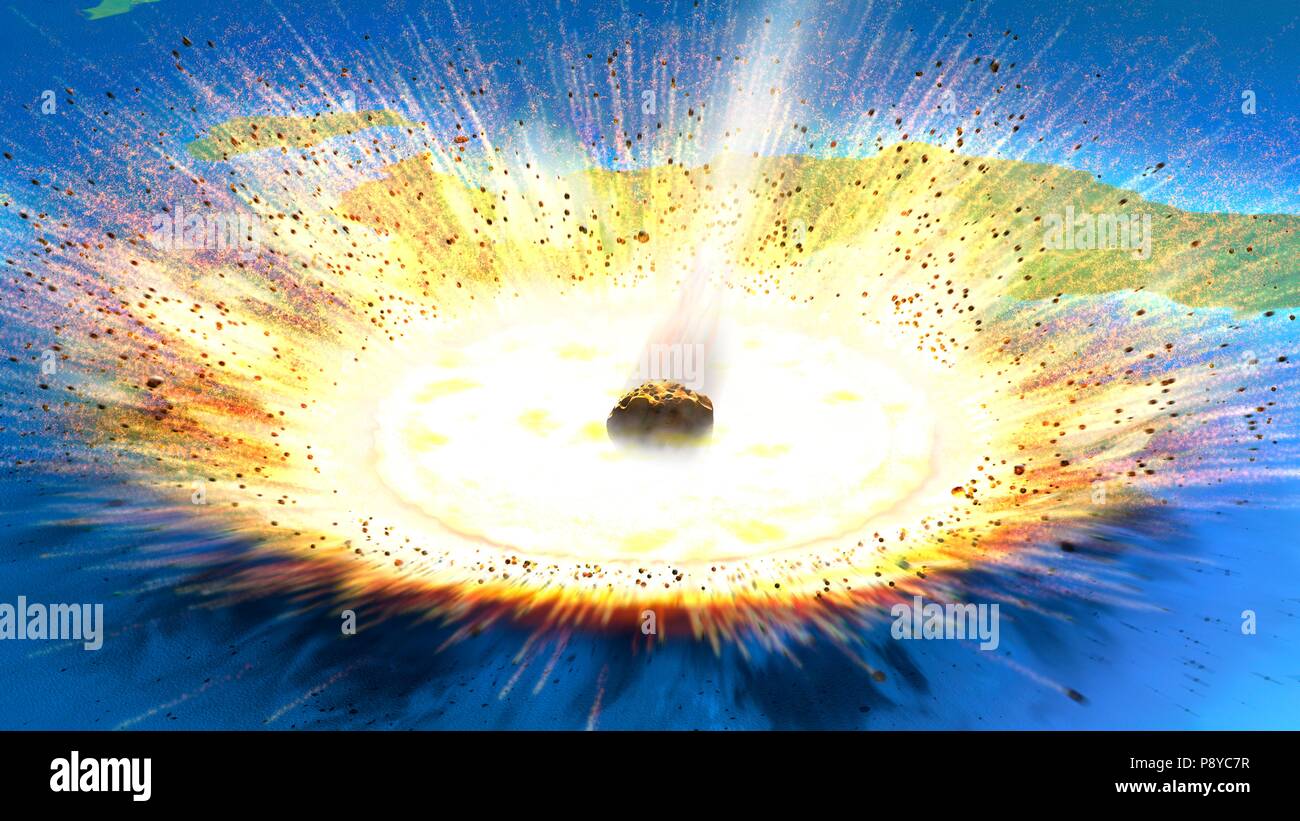 Asteroid impact. Illustration of a large asteroid colliding with Earth on the Yucatan Peninsula in Mexico. This impact is believed to have led to the death of the dinosaurs some 65 million years ago. The impact formed the Chicxulub crater, which is around 200 kilometres wide. The impact would have thrown trillions of tons of dust into the atmosphere, cooling the Earth's climate significantly, which may have been responsible for the mass extinction. A layer of iridium- rich rock, known as the K/pg boundary, is thought to be the remnants of the impact debris. Stock Photohttps://www.alamy.com/image-license-details/?v=1https://www.alamy.com/asteroid-impact-illustration-of-a-large-asteroid-colliding-with-earth-on-the-yucatan-peninsula-in-mexico-this-impact-is-believed-to-have-led-to-the-death-of-the-dinosaurs-some-65-million-years-ago-the-impact-formed-the-chicxulub-crater-which-is-around-200-kilometres-wide-the-impact-would-have-thrown-trillions-of-tons-of-dust-into-the-atmosphere-cooling-the-earths-climate-significantly-which-may-have-been-responsible-for-the-mass-extinction-a-layer-of-iridium-rich-rock-known-as-the-kpg-boundary-is-thought-to-be-the-remnants-of-the-impact-debris-image212043995.html
Asteroid impact. Illustration of a large asteroid colliding with Earth on the Yucatan Peninsula in Mexico. This impact is believed to have led to the death of the dinosaurs some 65 million years ago. The impact formed the Chicxulub crater, which is around 200 kilometres wide. The impact would have thrown trillions of tons of dust into the atmosphere, cooling the Earth's climate significantly, which may have been responsible for the mass extinction. A layer of iridium- rich rock, known as the K/pg boundary, is thought to be the remnants of the impact debris. Stock Photohttps://www.alamy.com/image-license-details/?v=1https://www.alamy.com/asteroid-impact-illustration-of-a-large-asteroid-colliding-with-earth-on-the-yucatan-peninsula-in-mexico-this-impact-is-believed-to-have-led-to-the-death-of-the-dinosaurs-some-65-million-years-ago-the-impact-formed-the-chicxulub-crater-which-is-around-200-kilometres-wide-the-impact-would-have-thrown-trillions-of-tons-of-dust-into-the-atmosphere-cooling-the-earths-climate-significantly-which-may-have-been-responsible-for-the-mass-extinction-a-layer-of-iridium-rich-rock-known-as-the-kpg-boundary-is-thought-to-be-the-remnants-of-the-impact-debris-image212043995.htmlRFP8YC7R–Asteroid impact. Illustration of a large asteroid colliding with Earth on the Yucatan Peninsula in Mexico. This impact is believed to have led to the death of the dinosaurs some 65 million years ago. The impact formed the Chicxulub crater, which is around 200 kilometres wide. The impact would have thrown trillions of tons of dust into the atmosphere, cooling the Earth's climate significantly, which may have been responsible for the mass extinction. A layer of iridium- rich rock, known as the K/pg boundary, is thought to be the remnants of the impact debris.
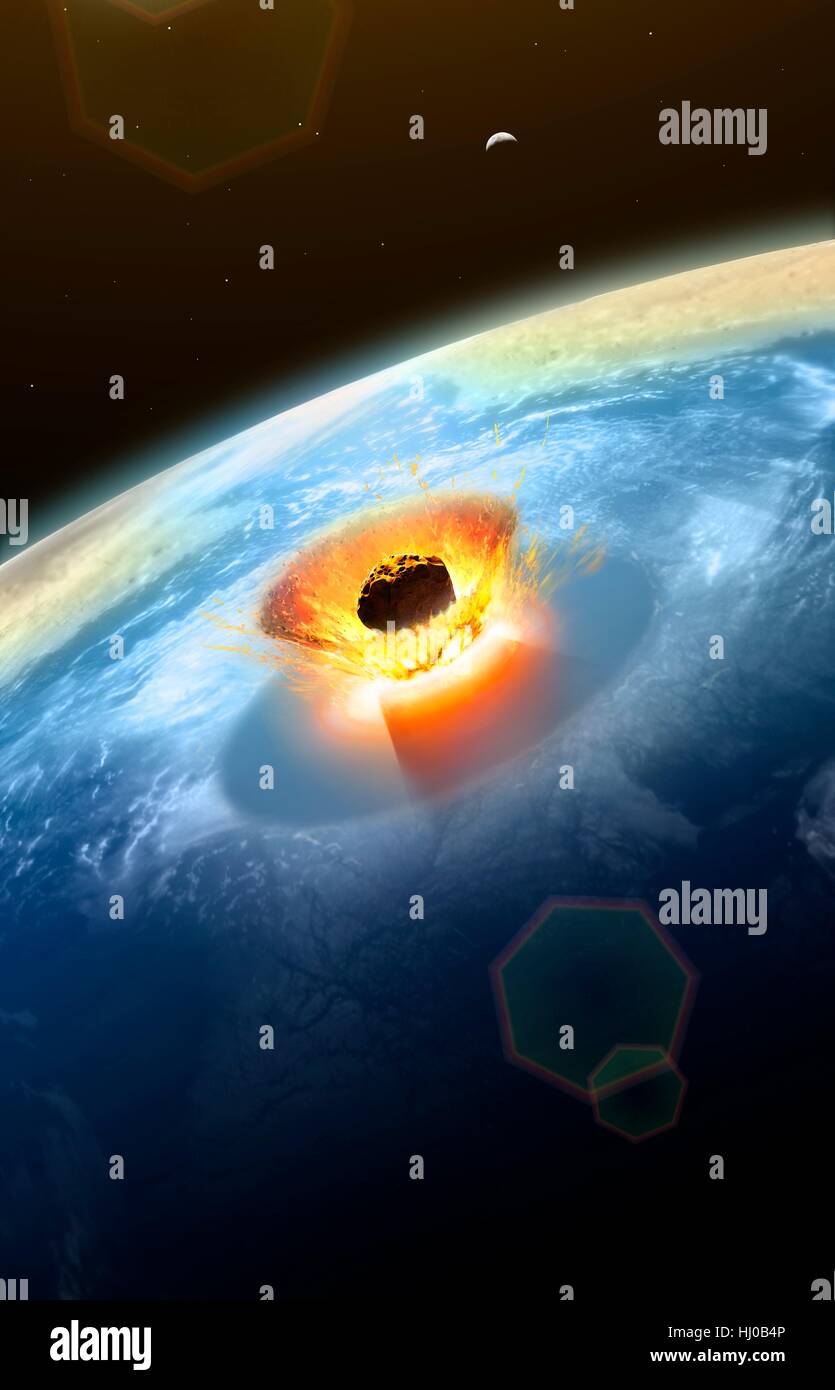 Asteroid impact. Illustration of a large asteroid colliding with Earth on the Yucatan Peninsula in (what is modern day) Mexico. This impact is believed to have led to the death of the dinosaurs some 65 million years ago. The impact formed the Chicxulub crater, which is around 200 kilometres wide. The impact would have thrown trillions of tons of dust into the atmosphere, cooling the Earth's climate significantly, which may have been responsible for the mass extinction. A layer of iridium- rich rock, known as the K pg boundary, is thought to be the remnants of the impact debris. Stock Photohttps://www.alamy.com/image-license-details/?v=1https://www.alamy.com/stock-photo-asteroid-impact-illustration-of-a-large-asteroid-colliding-with-earth-131545142.html
Asteroid impact. Illustration of a large asteroid colliding with Earth on the Yucatan Peninsula in (what is modern day) Mexico. This impact is believed to have led to the death of the dinosaurs some 65 million years ago. The impact formed the Chicxulub crater, which is around 200 kilometres wide. The impact would have thrown trillions of tons of dust into the atmosphere, cooling the Earth's climate significantly, which may have been responsible for the mass extinction. A layer of iridium- rich rock, known as the K pg boundary, is thought to be the remnants of the impact debris. Stock Photohttps://www.alamy.com/image-license-details/?v=1https://www.alamy.com/stock-photo-asteroid-impact-illustration-of-a-large-asteroid-colliding-with-earth-131545142.htmlRFHJ0B4P–Asteroid impact. Illustration of a large asteroid colliding with Earth on the Yucatan Peninsula in (what is modern day) Mexico. This impact is believed to have led to the death of the dinosaurs some 65 million years ago. The impact formed the Chicxulub crater, which is around 200 kilometres wide. The impact would have thrown trillions of tons of dust into the atmosphere, cooling the Earth's climate significantly, which may have been responsible for the mass extinction. A layer of iridium- rich rock, known as the K pg boundary, is thought to be the remnants of the impact debris.
 Tyrannosaurus rex and pteranodon looking at meteorite impact in Yucatan, Mexico, that created Chicxulub crater and induced end o Stock Photohttps://www.alamy.com/image-license-details/?v=1https://www.alamy.com/stock-photo-tyrannosaurus-rex-and-pteranodon-looking-at-meteorite-impact-in-yucatan-75611193.html
Tyrannosaurus rex and pteranodon looking at meteorite impact in Yucatan, Mexico, that created Chicxulub crater and induced end o Stock Photohttps://www.alamy.com/image-license-details/?v=1https://www.alamy.com/stock-photo-tyrannosaurus-rex-and-pteranodon-looking-at-meteorite-impact-in-yucatan-75611193.htmlRFEB0ARN–Tyrannosaurus rex and pteranodon looking at meteorite impact in Yucatan, Mexico, that created Chicxulub crater and induced end o
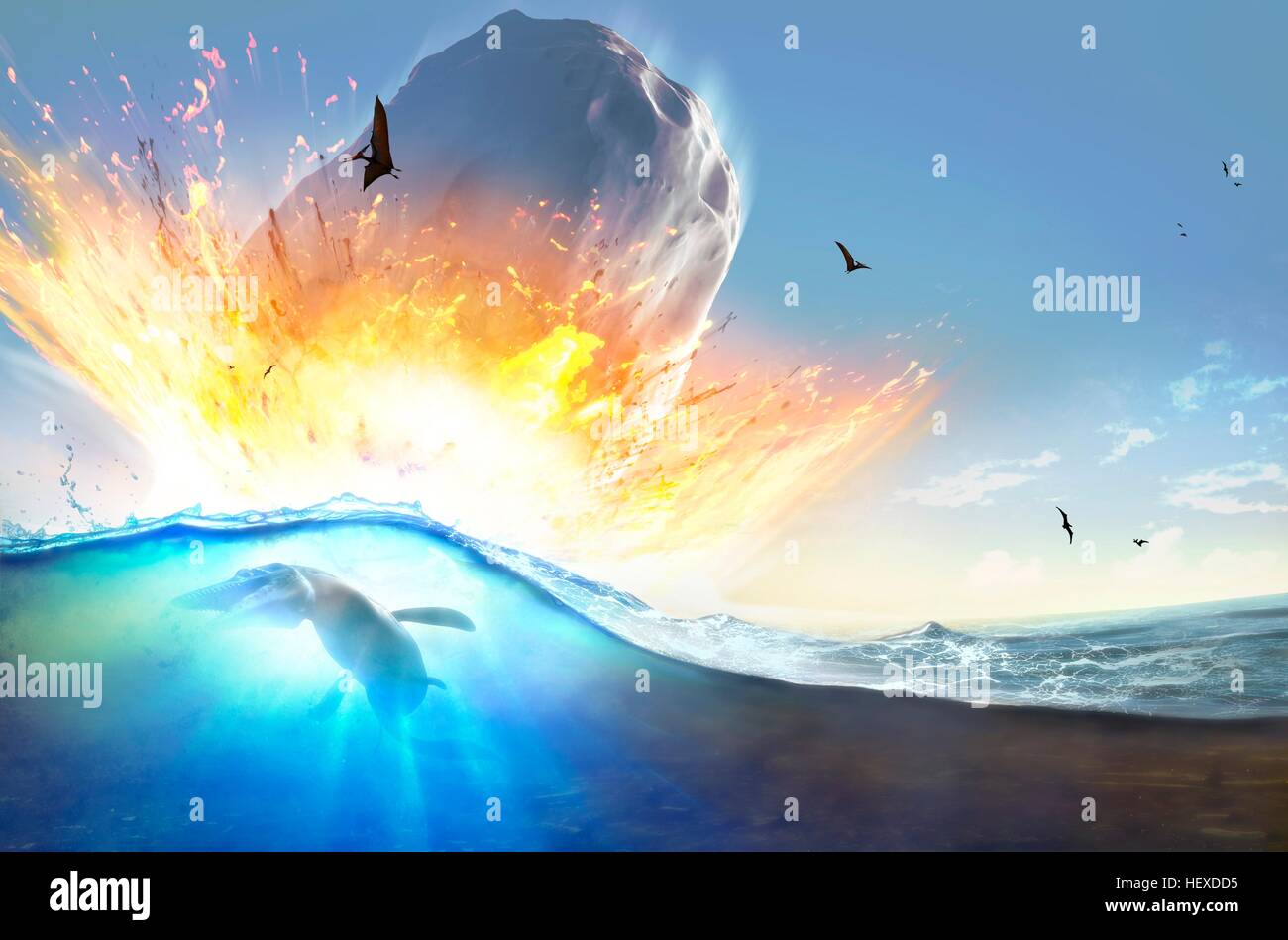 Asteroid impact.Illustration of large asteroid colliding Earth on Yucatan Peninsula in (what is modern day) Mexico.This impact is believed to have led to death of dinosaurs some 65 million years ago.The impact formed Chicxulub crater,which is around 200 kilometres wide.The impact would have thrown Stock Photohttps://www.alamy.com/image-license-details/?v=1https://www.alamy.com/stock-photo-asteroid-impactillustration-of-large-asteroid-colliding-earth-on-yucatan-129659073.html
Asteroid impact.Illustration of large asteroid colliding Earth on Yucatan Peninsula in (what is modern day) Mexico.This impact is believed to have led to death of dinosaurs some 65 million years ago.The impact formed Chicxulub crater,which is around 200 kilometres wide.The impact would have thrown Stock Photohttps://www.alamy.com/image-license-details/?v=1https://www.alamy.com/stock-photo-asteroid-impactillustration-of-large-asteroid-colliding-earth-on-yucatan-129659073.htmlRFHEXDD5–Asteroid impact.Illustration of large asteroid colliding Earth on Yucatan Peninsula in (what is modern day) Mexico.This impact is believed to have led to death of dinosaurs some 65 million years ago.The impact formed Chicxulub crater,which is around 200 kilometres wide.The impact would have thrown
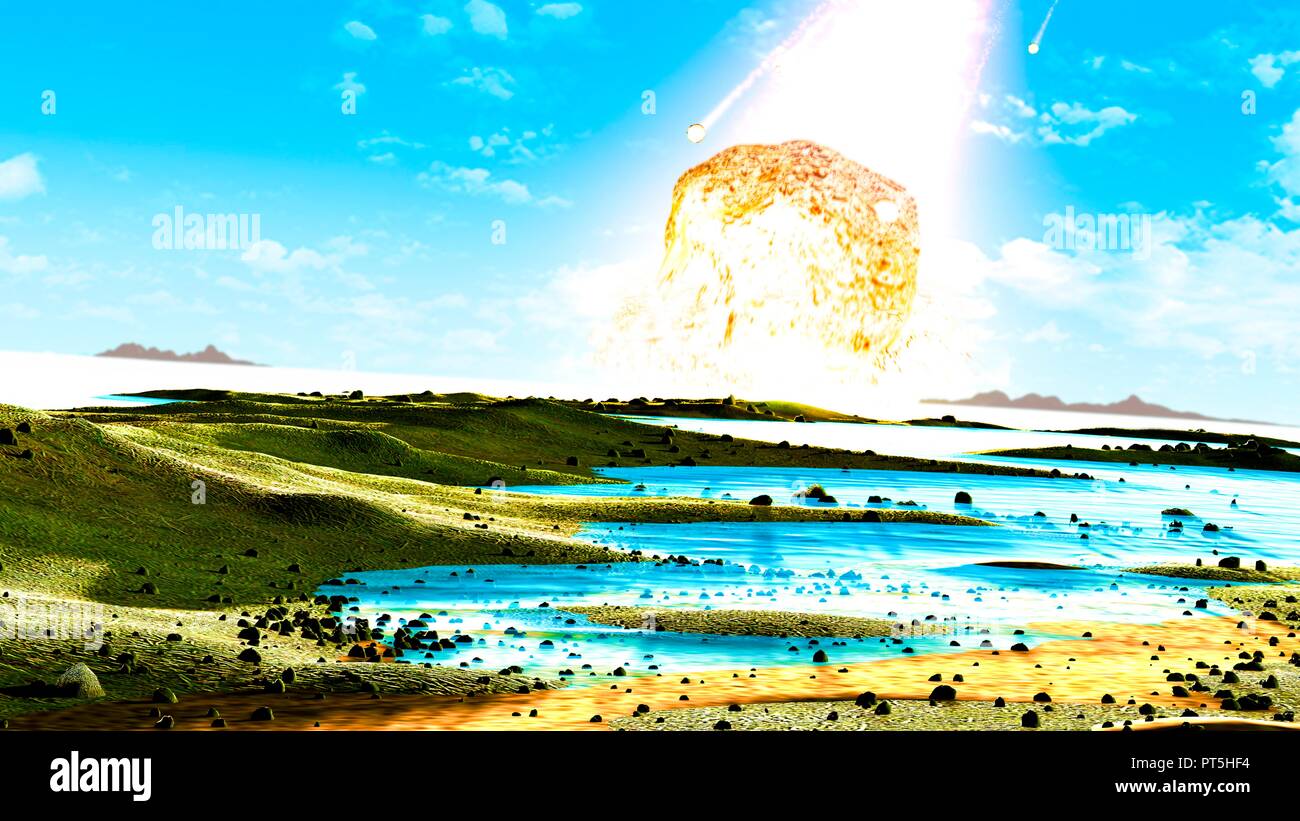 Asteroid impact. Illustration of a large asteroid colliding with Earth on the Yucatan Peninsula in Mexico. This impact is believed to have led to the death of the dinosaurs some 65 million years ago. The impact formed the Chicxulub crater, which is around 200 kilometres wide. The impact would have thrown trillions of tons of dust into the atmosphere, cooling the Earth's climate significantly, which may have been responsible for the mass extinction. A layer of iridium-rich rock, known as the K-pg boundary, is thought to be the remnants of the impact debris. Stock Photohttps://www.alamy.com/image-license-details/?v=1https://www.alamy.com/asteroid-impact-illustration-of-a-large-asteroid-colliding-with-earth-on-the-yucatan-peninsula-in-mexico-this-impact-is-believed-to-have-led-to-the-death-of-the-dinosaurs-some-65-million-years-ago-the-impact-formed-the-chicxulub-crater-which-is-around-200-kilometres-wide-the-impact-would-have-thrown-trillions-of-tons-of-dust-into-the-atmosphere-cooling-the-earths-climate-significantly-which-may-have-been-responsible-for-the-mass-extinction-a-layer-of-iridium-rich-rock-known-as-the-k-pg-boundary-is-thought-to-be-the-remnants-of-the-impact-debris-image221399672.html
Asteroid impact. Illustration of a large asteroid colliding with Earth on the Yucatan Peninsula in Mexico. This impact is believed to have led to the death of the dinosaurs some 65 million years ago. The impact formed the Chicxulub crater, which is around 200 kilometres wide. The impact would have thrown trillions of tons of dust into the atmosphere, cooling the Earth's climate significantly, which may have been responsible for the mass extinction. A layer of iridium-rich rock, known as the K-pg boundary, is thought to be the remnants of the impact debris. Stock Photohttps://www.alamy.com/image-license-details/?v=1https://www.alamy.com/asteroid-impact-illustration-of-a-large-asteroid-colliding-with-earth-on-the-yucatan-peninsula-in-mexico-this-impact-is-believed-to-have-led-to-the-death-of-the-dinosaurs-some-65-million-years-ago-the-impact-formed-the-chicxulub-crater-which-is-around-200-kilometres-wide-the-impact-would-have-thrown-trillions-of-tons-of-dust-into-the-atmosphere-cooling-the-earths-climate-significantly-which-may-have-been-responsible-for-the-mass-extinction-a-layer-of-iridium-rich-rock-known-as-the-k-pg-boundary-is-thought-to-be-the-remnants-of-the-impact-debris-image221399672.htmlRFPT5HF4–Asteroid impact. Illustration of a large asteroid colliding with Earth on the Yucatan Peninsula in Mexico. This impact is believed to have led to the death of the dinosaurs some 65 million years ago. The impact formed the Chicxulub crater, which is around 200 kilometres wide. The impact would have thrown trillions of tons of dust into the atmosphere, cooling the Earth's climate significantly, which may have been responsible for the mass extinction. A layer of iridium-rich rock, known as the K-pg boundary, is thought to be the remnants of the impact debris.
 Tyrannosaurus rex and pteranodon looking at meteorite impact in Yucatan, Mexico, that created Chicxulub crater and induced end of dinosaurs, vintage style - 3D render Stock Photohttps://www.alamy.com/image-license-details/?v=1https://www.alamy.com/stock-photo-tyrannosaurus-rex-and-pteranodon-looking-at-meteorite-impact-in-yucatan-146255520.html
Tyrannosaurus rex and pteranodon looking at meteorite impact in Yucatan, Mexico, that created Chicxulub crater and induced end of dinosaurs, vintage style - 3D render Stock Photohttps://www.alamy.com/image-license-details/?v=1https://www.alamy.com/stock-photo-tyrannosaurus-rex-and-pteranodon-looking-at-meteorite-impact-in-yucatan-146255520.htmlRFJDXEBC–Tyrannosaurus rex and pteranodon looking at meteorite impact in Yucatan, Mexico, that created Chicxulub crater and induced end of dinosaurs, vintage style - 3D render
![Infographic of the various theories about the disappearance of the dinosaurs. [QuarkXPress (.qxp); 6259x4015]. Stock Photo Infographic of the various theories about the disappearance of the dinosaurs. [QuarkXPress (.qxp); 6259x4015]. Stock Photo](https://c8.alamy.com/comp/2NEBP01/infographic-of-the-various-theories-about-the-disappearance-of-the-dinosaurs-quarkxpress-qxp-6259x4015-2NEBP01.jpg) Infographic of the various theories about the disappearance of the dinosaurs. [QuarkXPress (.qxp); 6259x4015]. Stock Photohttps://www.alamy.com/image-license-details/?v=1https://www.alamy.com/infographic-of-the-various-theories-about-the-disappearance-of-the-dinosaurs-quarkxpress-qxp-6259x4015-image525174945.html
Infographic of the various theories about the disappearance of the dinosaurs. [QuarkXPress (.qxp); 6259x4015]. Stock Photohttps://www.alamy.com/image-license-details/?v=1https://www.alamy.com/infographic-of-the-various-theories-about-the-disappearance-of-the-dinosaurs-quarkxpress-qxp-6259x4015-image525174945.htmlRM2NEBP01–Infographic of the various theories about the disappearance of the dinosaurs. [QuarkXPress (.qxp); 6259x4015].
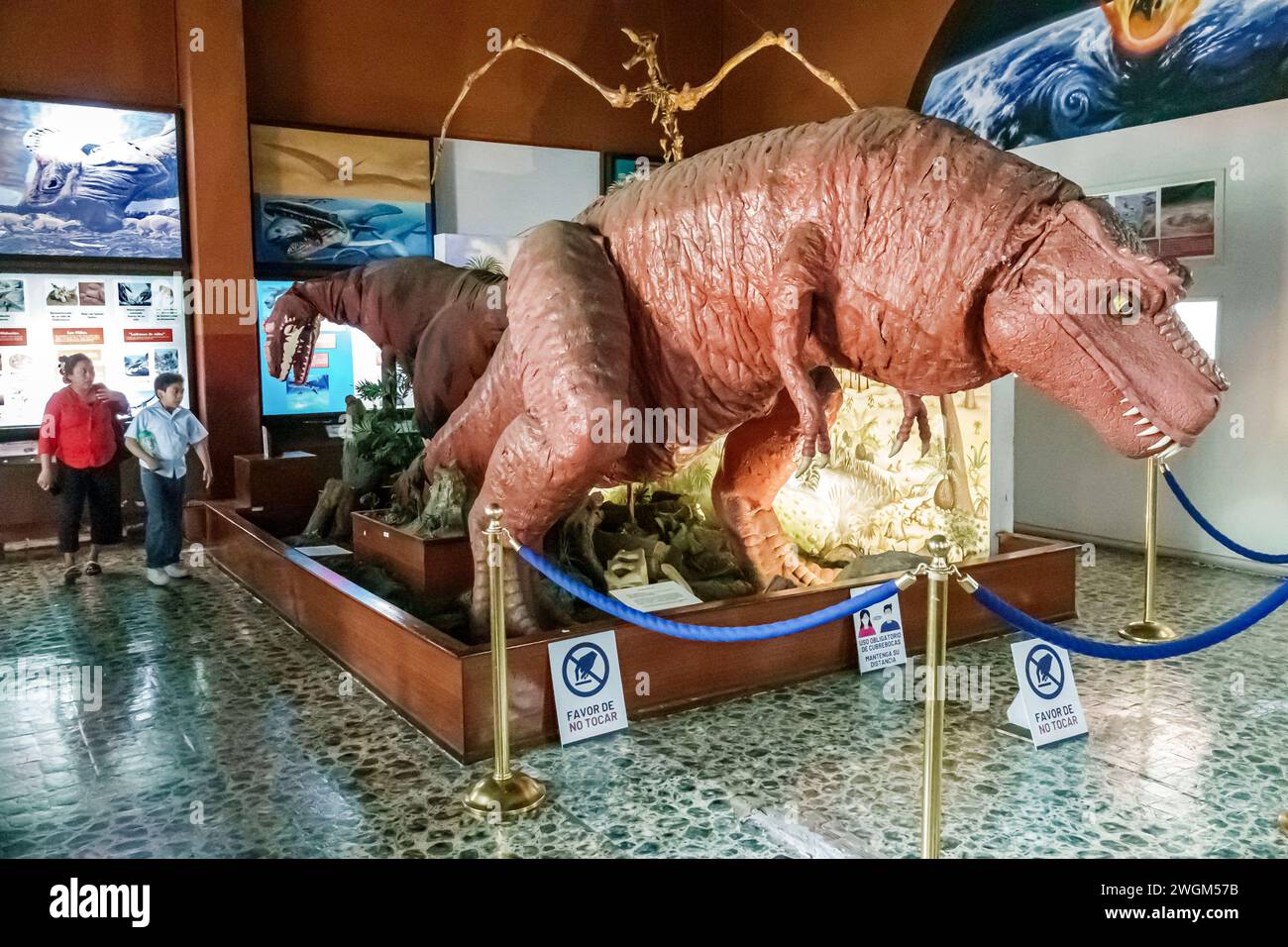 Merida Mexico,Centro,Museo de Historia Natural history museum,inside interior,exhibit exhibits display displays collection,collections gallery galleri Stock Photohttps://www.alamy.com/image-license-details/?v=1https://www.alamy.com/merida-mexicocentromuseo-de-historia-natural-history-museuminside-interiorexhibit-exhibits-display-displays-collectioncollections-gallery-galleri-image595430175.html
Merida Mexico,Centro,Museo de Historia Natural history museum,inside interior,exhibit exhibits display displays collection,collections gallery galleri Stock Photohttps://www.alamy.com/image-license-details/?v=1https://www.alamy.com/merida-mexicocentromuseo-de-historia-natural-history-museuminside-interiorexhibit-exhibits-display-displays-collectioncollections-gallery-galleri-image595430175.htmlRM2WGM57B–Merida Mexico,Centro,Museo de Historia Natural history museum,inside interior,exhibit exhibits display displays collection,collections gallery galleri
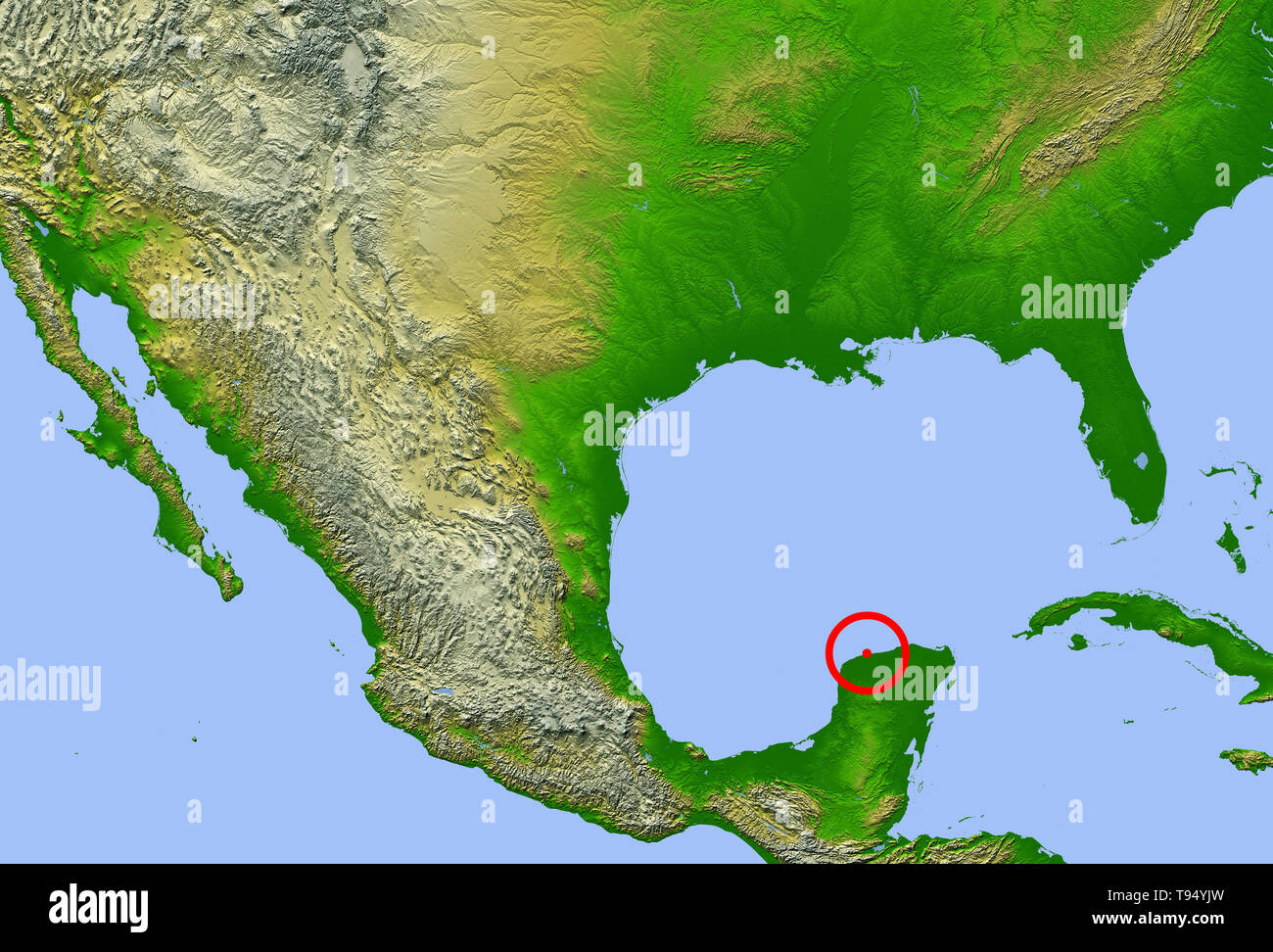 Chicxulub crater. Map showing the location of the Chicxulub impact crater (center) on the Yucatan Peninsula, Mexico. This impact may have caused the extinction of the dinosaurs and 70% of all Earth's species 65 million years ago. The four red dots represent the cities of (from left to right): Mexico City, Tempico (where material ejected from the crater has been found), Havana and Miami. Stock Photohttps://www.alamy.com/image-license-details/?v=1https://www.alamy.com/chicxulub-crater-map-showing-the-location-of-the-chicxulub-impact-crater-center-on-the-yucatan-peninsula-mexico-this-impact-may-have-caused-the-extinction-of-the-dinosaurs-and-70-of-all-earths-species-65-million-years-ago-the-four-red-dots-represent-the-cities-of-from-left-to-right-mexico-city-tempico-where-material-ejected-from-the-crater-has-been-found-havana-and-miami-image246586561.html
Chicxulub crater. Map showing the location of the Chicxulub impact crater (center) on the Yucatan Peninsula, Mexico. This impact may have caused the extinction of the dinosaurs and 70% of all Earth's species 65 million years ago. The four red dots represent the cities of (from left to right): Mexico City, Tempico (where material ejected from the crater has been found), Havana and Miami. Stock Photohttps://www.alamy.com/image-license-details/?v=1https://www.alamy.com/chicxulub-crater-map-showing-the-location-of-the-chicxulub-impact-crater-center-on-the-yucatan-peninsula-mexico-this-impact-may-have-caused-the-extinction-of-the-dinosaurs-and-70-of-all-earths-species-65-million-years-ago-the-four-red-dots-represent-the-cities-of-from-left-to-right-mexico-city-tempico-where-material-ejected-from-the-crater-has-been-found-havana-and-miami-image246586561.htmlRMT94YJW–Chicxulub crater. Map showing the location of the Chicxulub impact crater (center) on the Yucatan Peninsula, Mexico. This impact may have caused the extinction of the dinosaurs and 70% of all Earth's species 65 million years ago. The four red dots represent the cities of (from left to right): Mexico City, Tempico (where material ejected from the crater has been found), Havana and Miami.
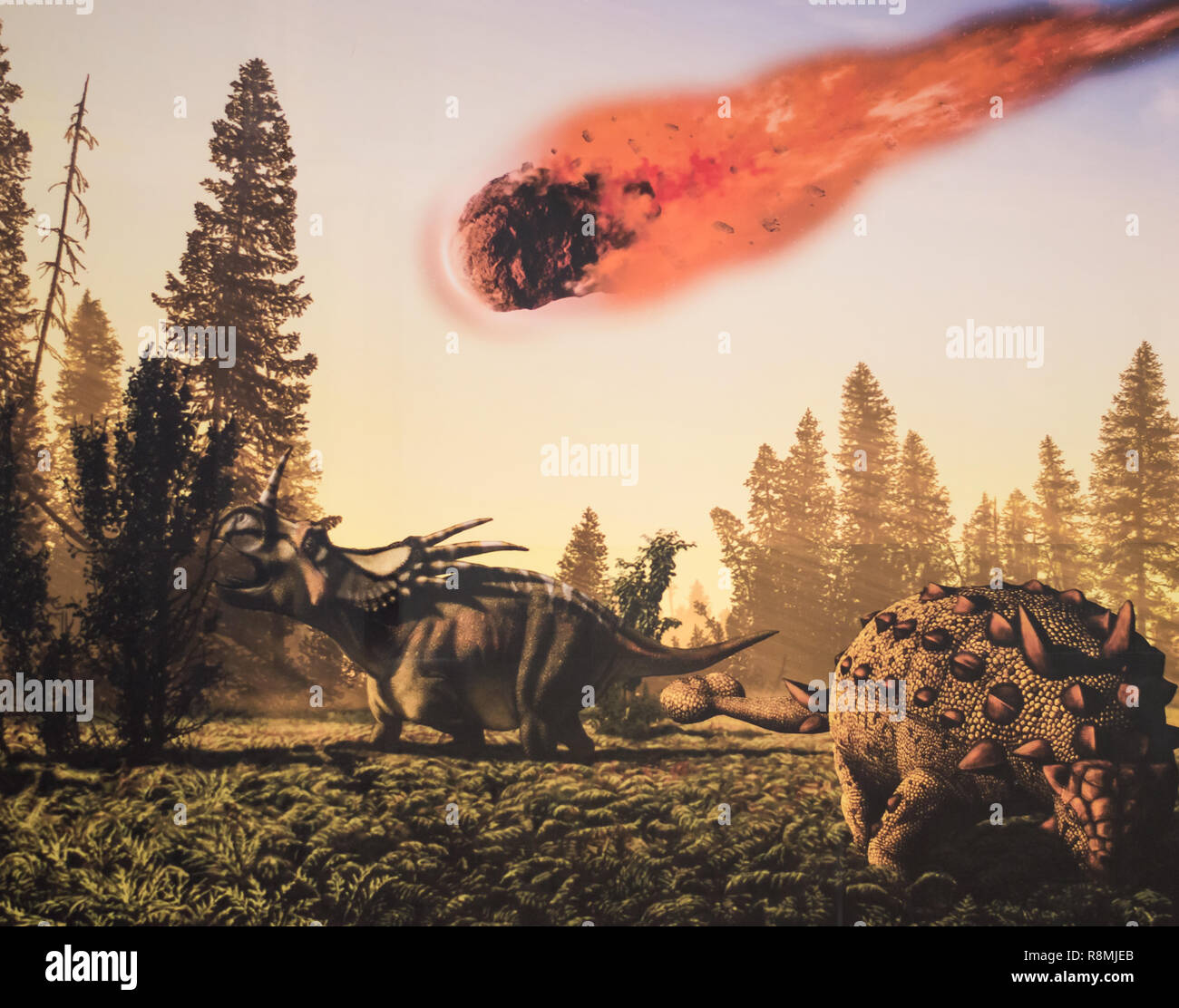 Mural at the Museo de Ciencias del Crater in Yucatan, depicting the asteroid which impacted into Chicxulub, leading to the extinction of dinosaurs. Stock Photohttps://www.alamy.com/image-license-details/?v=1https://www.alamy.com/mural-at-the-museo-de-ciencias-del-crater-in-yucatan-depicting-the-asteroid-which-impacted-into-chicxulub-leading-to-the-extinction-of-dinosaurs-image229105587.html
Mural at the Museo de Ciencias del Crater in Yucatan, depicting the asteroid which impacted into Chicxulub, leading to the extinction of dinosaurs. Stock Photohttps://www.alamy.com/image-license-details/?v=1https://www.alamy.com/mural-at-the-museo-de-ciencias-del-crater-in-yucatan-depicting-the-asteroid-which-impacted-into-chicxulub-leading-to-the-extinction-of-dinosaurs-image229105587.htmlRFR8MJEB–Mural at the Museo de Ciencias del Crater in Yucatan, depicting the asteroid which impacted into Chicxulub, leading to the extinction of dinosaurs.
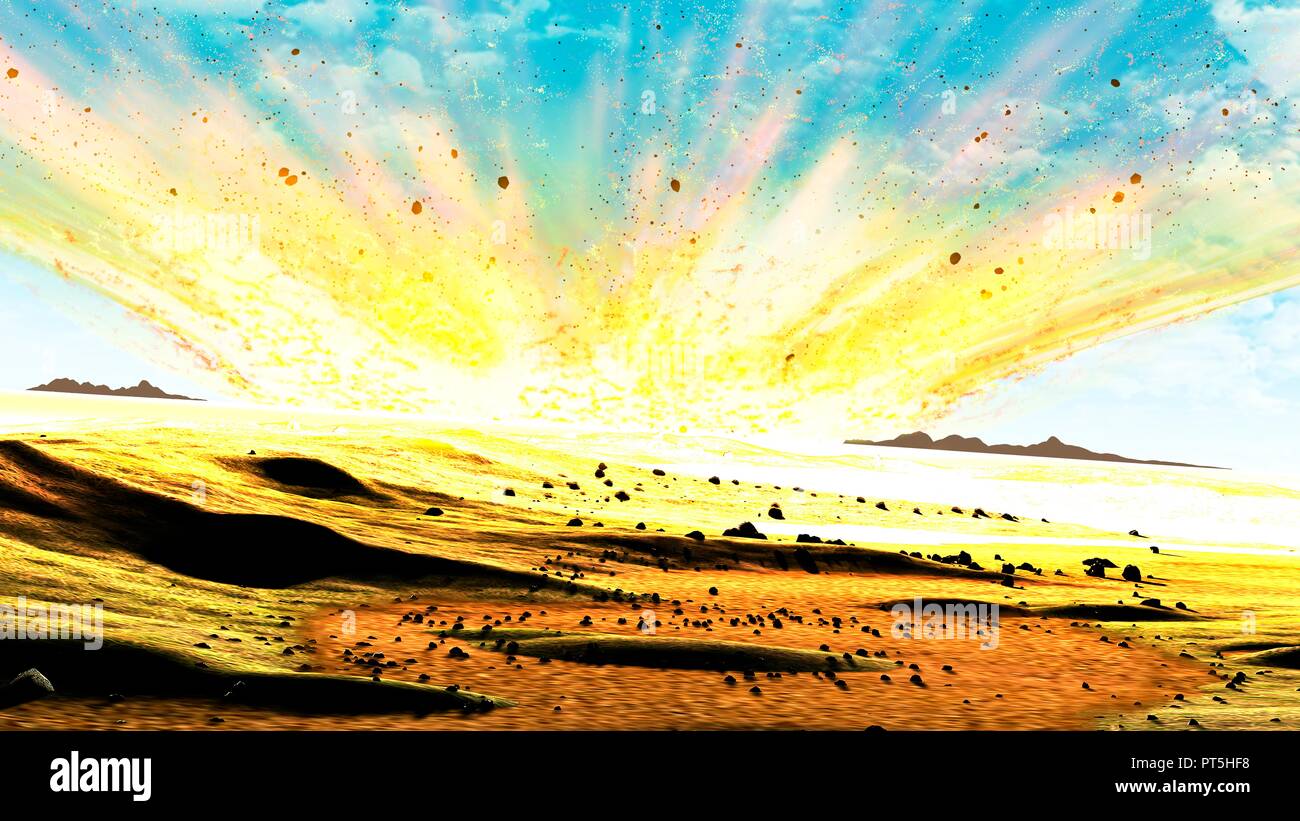 Asteroid impact. Illustration of a large asteroid colliding with Earth on the Yucatan Peninsula in Mexico. This impact is believed to have led to the death of the dinosaurs some 65 million years ago. The impact formed the Chicxulub crater, which is around 200 kilometres wide. The impact would have thrown trillions of tons of dust into the atmosphere, cooling the Earth's climate significantly, which may have been responsible for the mass extinction. A layer of iridium-rich rock, known as the K-pg boundary, is thought to be the remnants of the impact debris. Stock Photohttps://www.alamy.com/image-license-details/?v=1https://www.alamy.com/asteroid-impact-illustration-of-a-large-asteroid-colliding-with-earth-on-the-yucatan-peninsula-in-mexico-this-impact-is-believed-to-have-led-to-the-death-of-the-dinosaurs-some-65-million-years-ago-the-impact-formed-the-chicxulub-crater-which-is-around-200-kilometres-wide-the-impact-would-have-thrown-trillions-of-tons-of-dust-into-the-atmosphere-cooling-the-earths-climate-significantly-which-may-have-been-responsible-for-the-mass-extinction-a-layer-of-iridium-rich-rock-known-as-the-k-pg-boundary-is-thought-to-be-the-remnants-of-the-impact-debris-image221399676.html
Asteroid impact. Illustration of a large asteroid colliding with Earth on the Yucatan Peninsula in Mexico. This impact is believed to have led to the death of the dinosaurs some 65 million years ago. The impact formed the Chicxulub crater, which is around 200 kilometres wide. The impact would have thrown trillions of tons of dust into the atmosphere, cooling the Earth's climate significantly, which may have been responsible for the mass extinction. A layer of iridium-rich rock, known as the K-pg boundary, is thought to be the remnants of the impact debris. Stock Photohttps://www.alamy.com/image-license-details/?v=1https://www.alamy.com/asteroid-impact-illustration-of-a-large-asteroid-colliding-with-earth-on-the-yucatan-peninsula-in-mexico-this-impact-is-believed-to-have-led-to-the-death-of-the-dinosaurs-some-65-million-years-ago-the-impact-formed-the-chicxulub-crater-which-is-around-200-kilometres-wide-the-impact-would-have-thrown-trillions-of-tons-of-dust-into-the-atmosphere-cooling-the-earths-climate-significantly-which-may-have-been-responsible-for-the-mass-extinction-a-layer-of-iridium-rich-rock-known-as-the-k-pg-boundary-is-thought-to-be-the-remnants-of-the-impact-debris-image221399676.htmlRFPT5HF8–Asteroid impact. Illustration of a large asteroid colliding with Earth on the Yucatan Peninsula in Mexico. This impact is believed to have led to the death of the dinosaurs some 65 million years ago. The impact formed the Chicxulub crater, which is around 200 kilometres wide. The impact would have thrown trillions of tons of dust into the atmosphere, cooling the Earth's climate significantly, which may have been responsible for the mass extinction. A layer of iridium-rich rock, known as the K-pg boundary, is thought to be the remnants of the impact debris.
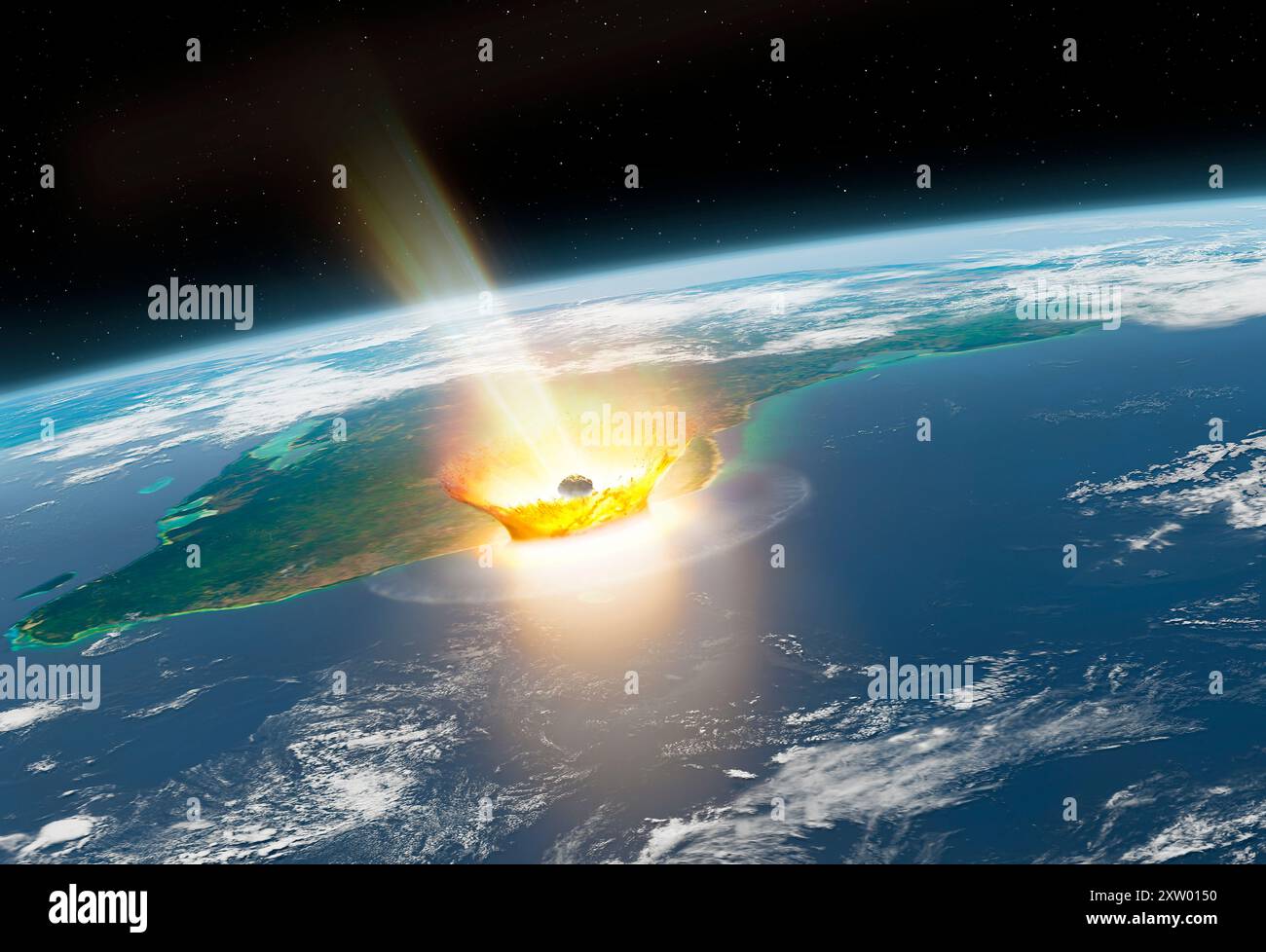 Asteroid impact. Illustration of a large asteroid colliding with Earth on the Yucatan Peninsula in Mexico. This impact is believed to have led to the death of the dinosaurs some 65 million years ago. The impact formed the Chicxulub crater, which is around 200 kilometres wide. The impact would have thrown trillions of tons of dust into the atmosphere, cooling the Earth's climate significantly, which may have been responsible for the mass extinction. A layer of iridium- rich rock, known as the K-Pg boundary, is thought to be the remnants of the impact debris. Stock Photohttps://www.alamy.com/image-license-details/?v=1https://www.alamy.com/asteroid-impact-illustration-of-a-large-asteroid-colliding-with-earth-on-the-yucatan-peninsula-in-mexico-this-impact-is-believed-to-have-led-to-the-death-of-the-dinosaurs-some-65-million-years-ago-the-impact-formed-the-chicxulub-crater-which-is-around-200-kilometres-wide-the-impact-would-have-thrown-trillions-of-tons-of-dust-into-the-atmosphere-cooling-the-earths-climate-significantly-which-may-have-been-responsible-for-the-mass-extinction-a-layer-of-iridium-rich-rock-known-as-the-k-pg-boundary-is-thought-to-be-the-remnants-of-the-impact-debris-image617730204.html
Asteroid impact. Illustration of a large asteroid colliding with Earth on the Yucatan Peninsula in Mexico. This impact is believed to have led to the death of the dinosaurs some 65 million years ago. The impact formed the Chicxulub crater, which is around 200 kilometres wide. The impact would have thrown trillions of tons of dust into the atmosphere, cooling the Earth's climate significantly, which may have been responsible for the mass extinction. A layer of iridium- rich rock, known as the K-Pg boundary, is thought to be the remnants of the impact debris. Stock Photohttps://www.alamy.com/image-license-details/?v=1https://www.alamy.com/asteroid-impact-illustration-of-a-large-asteroid-colliding-with-earth-on-the-yucatan-peninsula-in-mexico-this-impact-is-believed-to-have-led-to-the-death-of-the-dinosaurs-some-65-million-years-ago-the-impact-formed-the-chicxulub-crater-which-is-around-200-kilometres-wide-the-impact-would-have-thrown-trillions-of-tons-of-dust-into-the-atmosphere-cooling-the-earths-climate-significantly-which-may-have-been-responsible-for-the-mass-extinction-a-layer-of-iridium-rich-rock-known-as-the-k-pg-boundary-is-thought-to-be-the-remnants-of-the-impact-debris-image617730204.htmlRF2XW0150–Asteroid impact. Illustration of a large asteroid colliding with Earth on the Yucatan Peninsula in Mexico. This impact is believed to have led to the death of the dinosaurs some 65 million years ago. The impact formed the Chicxulub crater, which is around 200 kilometres wide. The impact would have thrown trillions of tons of dust into the atmosphere, cooling the Earth's climate significantly, which may have been responsible for the mass extinction. A layer of iridium- rich rock, known as the K-Pg boundary, is thought to be the remnants of the impact debris.
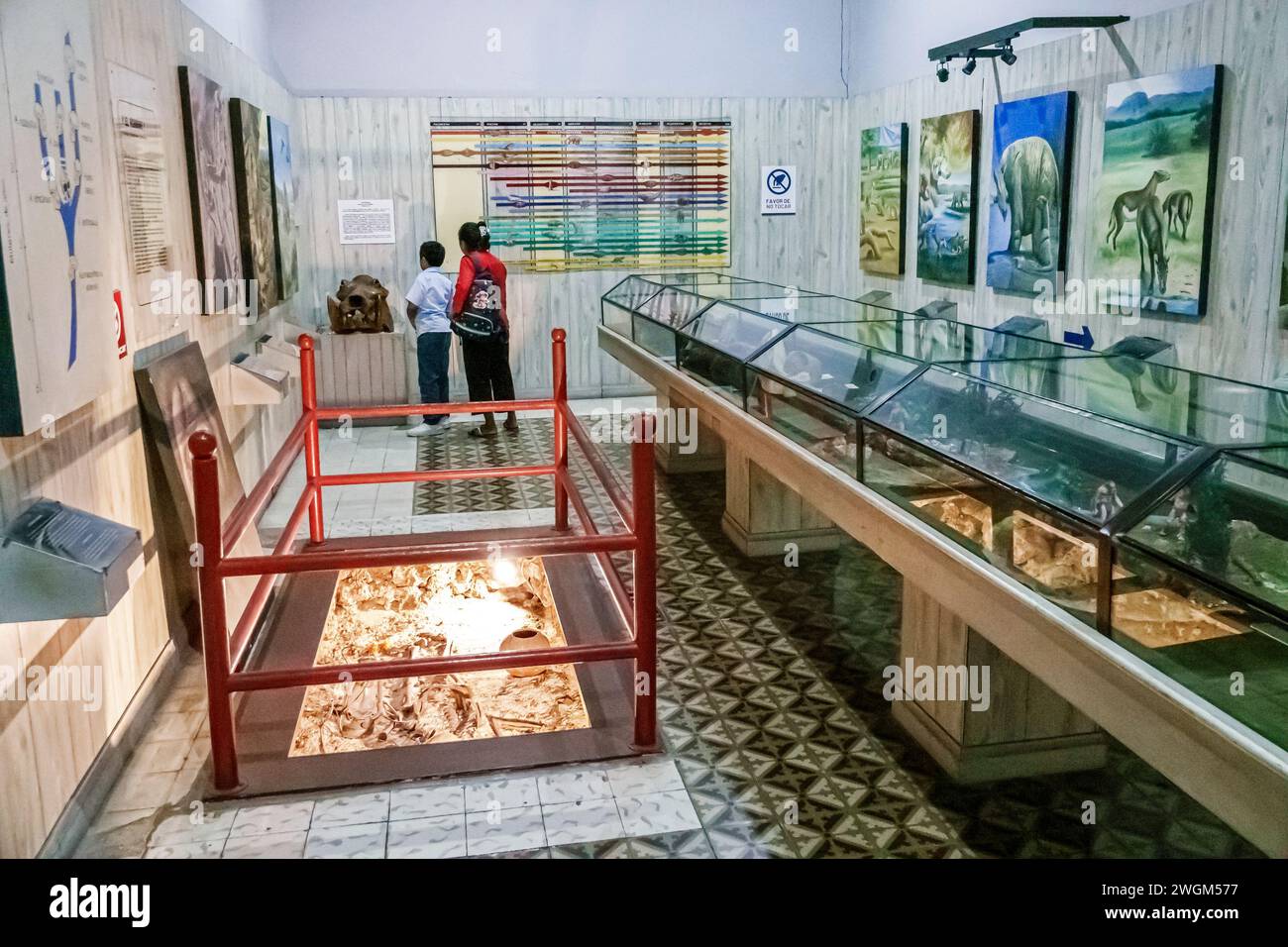 Merida Mexico,Centro,Museo de Historia Natural history museum,inside interior,exhibit exhibits display displays collection,collections gallery galleri Stock Photohttps://www.alamy.com/image-license-details/?v=1https://www.alamy.com/merida-mexicocentromuseo-de-historia-natural-history-museuminside-interiorexhibit-exhibits-display-displays-collectioncollections-gallery-galleri-image595430171.html
Merida Mexico,Centro,Museo de Historia Natural history museum,inside interior,exhibit exhibits display displays collection,collections gallery galleri Stock Photohttps://www.alamy.com/image-license-details/?v=1https://www.alamy.com/merida-mexicocentromuseo-de-historia-natural-history-museuminside-interiorexhibit-exhibits-display-displays-collectioncollections-gallery-galleri-image595430171.htmlRM2WGM577–Merida Mexico,Centro,Museo de Historia Natural history museum,inside interior,exhibit exhibits display displays collection,collections gallery galleri
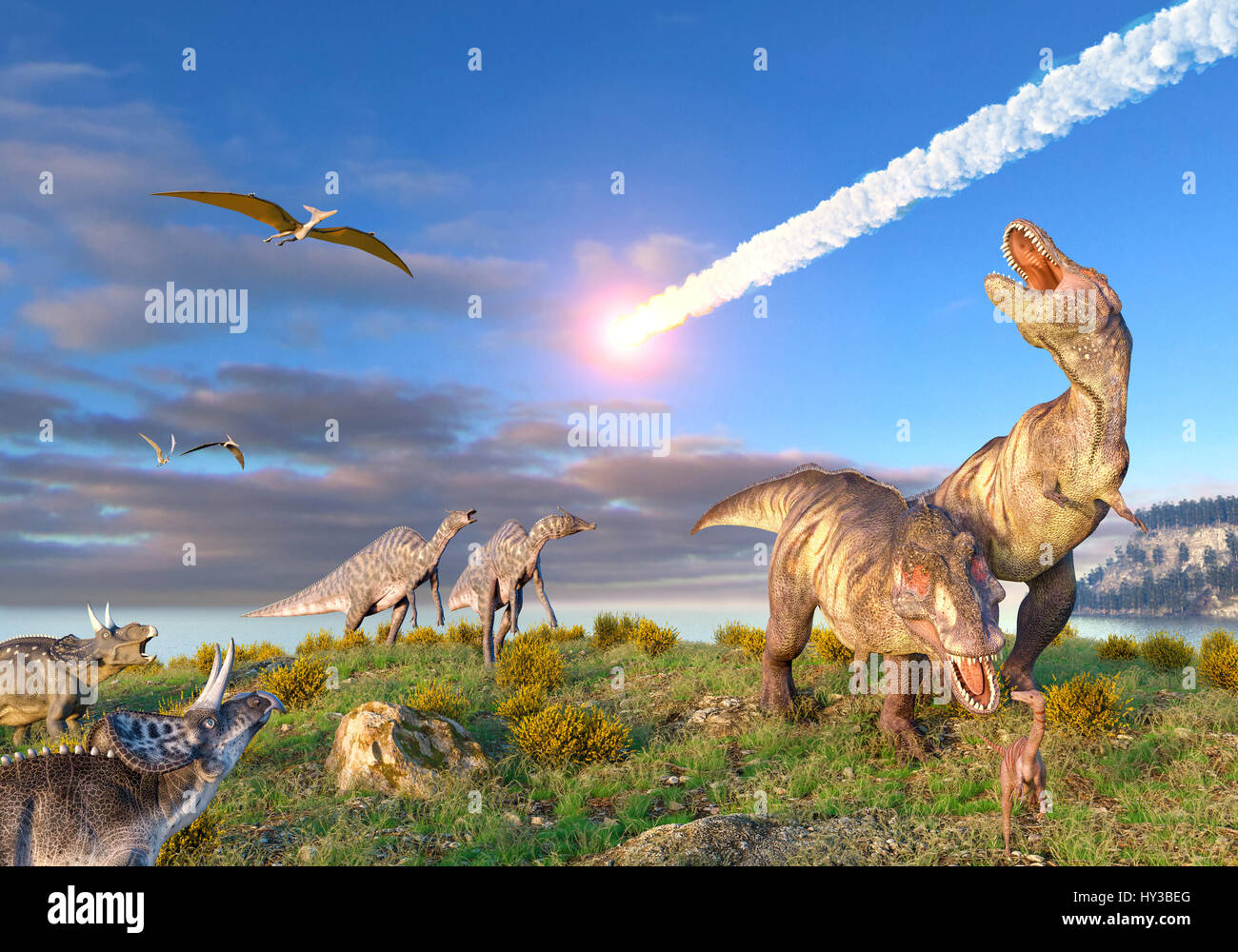 Illustration of the K/T Event at the end of the Cretaceous Period. A ten-kilometre-wide asteroid or comet is entering the Earth's atmosphere as dinosaurs, including T. rex, look on. Stock Photohttps://www.alamy.com/image-license-details/?v=1https://www.alamy.com/stock-photo-illustration-of-the-kt-event-at-the-end-of-the-cretaceous-period-a-137143176.html
Illustration of the K/T Event at the end of the Cretaceous Period. A ten-kilometre-wide asteroid or comet is entering the Earth's atmosphere as dinosaurs, including T. rex, look on. Stock Photohttps://www.alamy.com/image-license-details/?v=1https://www.alamy.com/stock-photo-illustration-of-the-kt-event-at-the-end-of-the-cretaceous-period-a-137143176.htmlRFHY3BEG–Illustration of the K/T Event at the end of the Cretaceous Period. A ten-kilometre-wide asteroid or comet is entering the Earth's atmosphere as dinosaurs, including T. rex, look on.
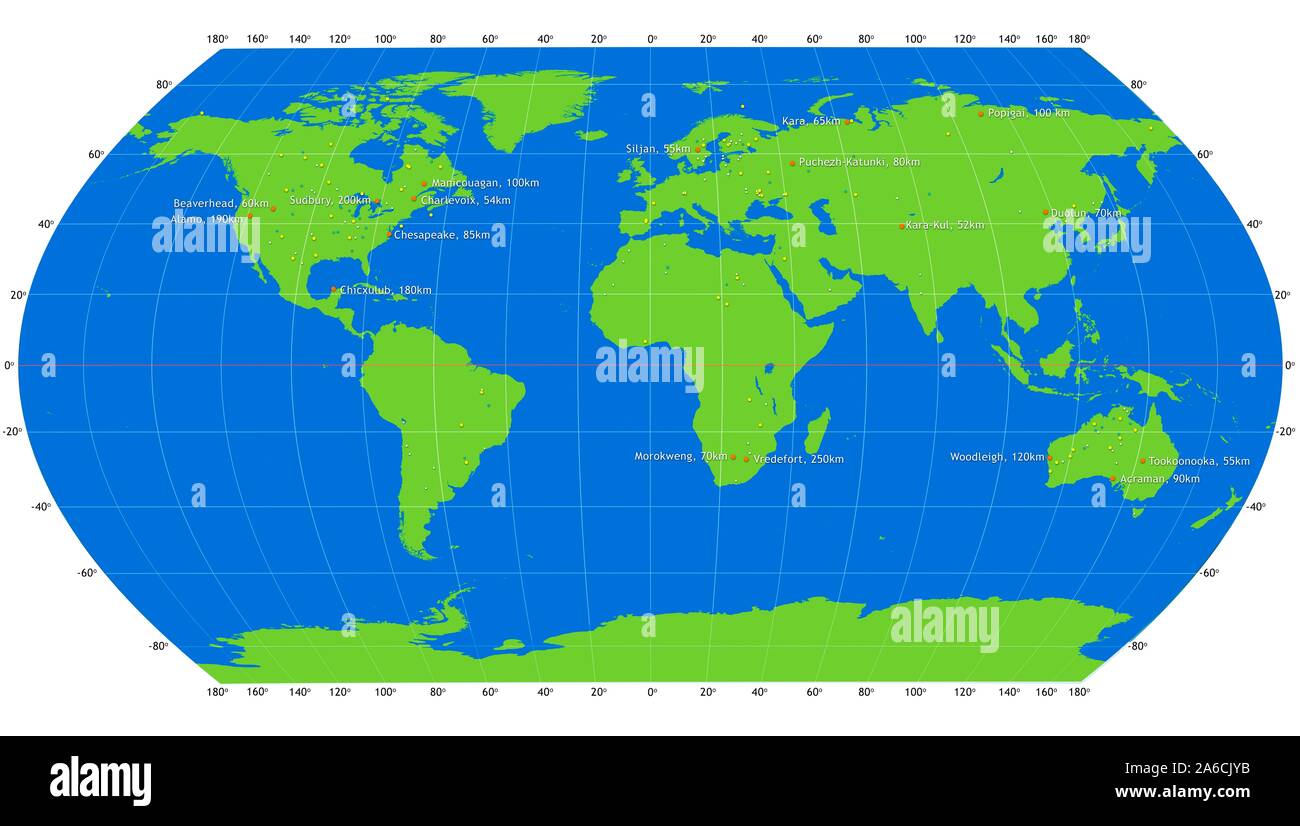 Map of all confirmed impact craters on Earth. The craters are sorted into size groups by colour, as follows. White: 0-5km diameter. Green: 5-10km diameter. Yellow: 10-50km diameter. Orange: greater than 50km diameter. Eighteen craters fall into the latter category, which are labelled. They include Chicxulub in the Gulf of Mexico, which led to the extinction of the dinosaurs, and Vredefort in South Africa, the largest known impact structure in Earth. Stock Photohttps://www.alamy.com/image-license-details/?v=1https://www.alamy.com/map-of-all-confirmed-impact-craters-on-earth-the-craters-are-sorted-into-size-groups-by-colour-as-follows-white-0-5km-diameter-green-5-10km-diameter-yellow-10-50km-diameter-orange-greater-than-50km-diameter-eighteen-craters-fall-into-the-latter-category-which-are-labelled-they-include-chicxulub-in-the-gulf-of-mexico-which-led-to-the-extinction-of-the-dinosaurs-and-vredefort-in-south-africa-the-largest-known-impact-structure-in-earth-image330963231.html
Map of all confirmed impact craters on Earth. The craters are sorted into size groups by colour, as follows. White: 0-5km diameter. Green: 5-10km diameter. Yellow: 10-50km diameter. Orange: greater than 50km diameter. Eighteen craters fall into the latter category, which are labelled. They include Chicxulub in the Gulf of Mexico, which led to the extinction of the dinosaurs, and Vredefort in South Africa, the largest known impact structure in Earth. Stock Photohttps://www.alamy.com/image-license-details/?v=1https://www.alamy.com/map-of-all-confirmed-impact-craters-on-earth-the-craters-are-sorted-into-size-groups-by-colour-as-follows-white-0-5km-diameter-green-5-10km-diameter-yellow-10-50km-diameter-orange-greater-than-50km-diameter-eighteen-craters-fall-into-the-latter-category-which-are-labelled-they-include-chicxulub-in-the-gulf-of-mexico-which-led-to-the-extinction-of-the-dinosaurs-and-vredefort-in-south-africa-the-largest-known-impact-structure-in-earth-image330963231.htmlRF2A6CJYB–Map of all confirmed impact craters on Earth. The craters are sorted into size groups by colour, as follows. White: 0-5km diameter. Green: 5-10km diameter. Yellow: 10-50km diameter. Orange: greater than 50km diameter. Eighteen craters fall into the latter category, which are labelled. They include Chicxulub in the Gulf of Mexico, which led to the extinction of the dinosaurs, and Vredefort in South Africa, the largest known impact structure in Earth.
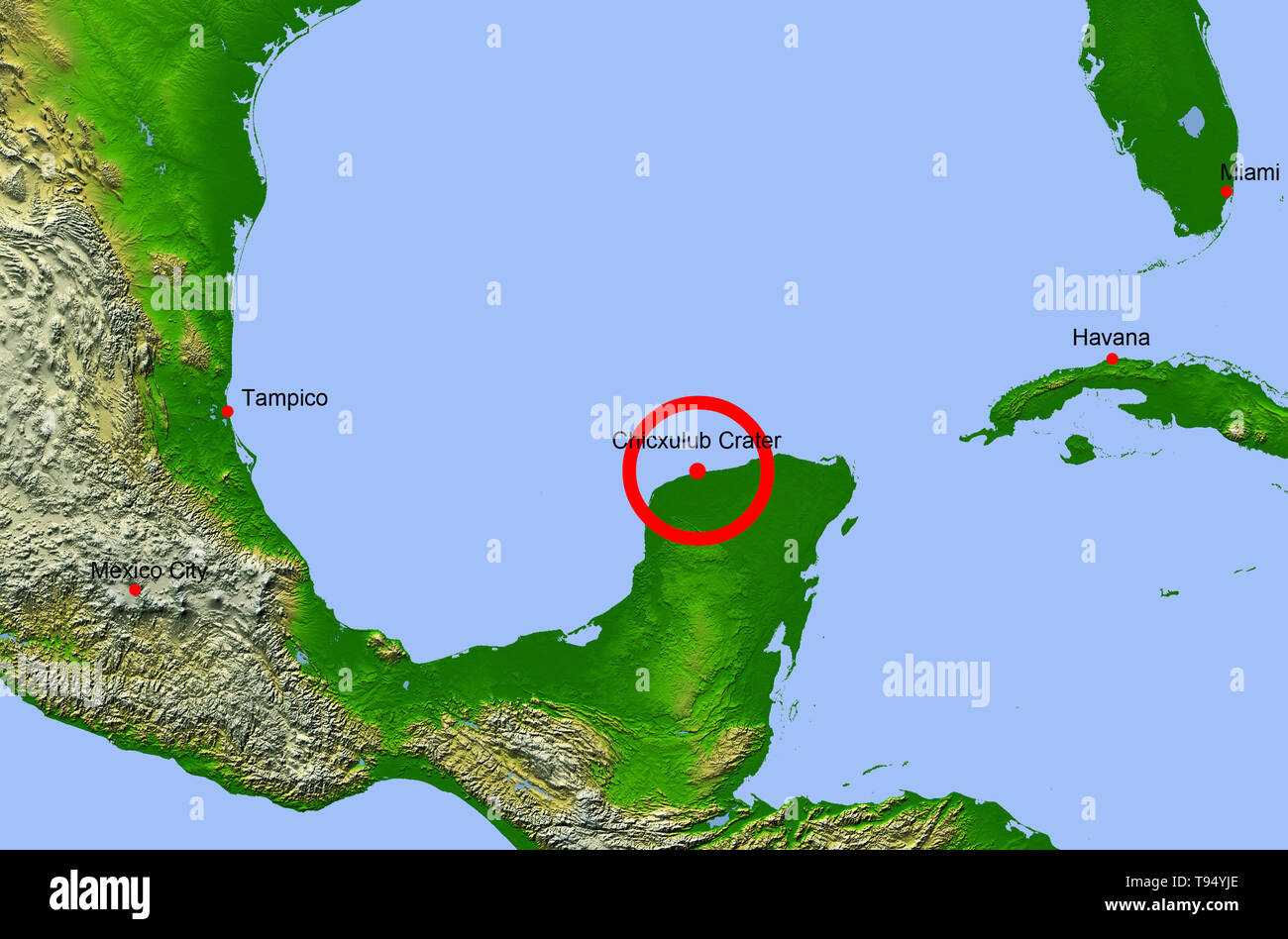 Chicxulub crater. Map showing the location of the Chicxulub impact crater (center) on the Yucatan Peninsula, Mexico. This impact may have caused the extinction of the dinosaurs and 70% of all Earth's species 65 million years ago. The four red dots represent the cities of (from left to right): Mexico City, Tempico (where material ejected from the crater has been found), Havana and Miami. Stock Photohttps://www.alamy.com/image-license-details/?v=1https://www.alamy.com/chicxulub-crater-map-showing-the-location-of-the-chicxulub-impact-crater-center-on-the-yucatan-peninsula-mexico-this-impact-may-have-caused-the-extinction-of-the-dinosaurs-and-70-of-all-earths-species-65-million-years-ago-the-four-red-dots-represent-the-cities-of-from-left-to-right-mexico-city-tempico-where-material-ejected-from-the-crater-has-been-found-havana-and-miami-image246586550.html
Chicxulub crater. Map showing the location of the Chicxulub impact crater (center) on the Yucatan Peninsula, Mexico. This impact may have caused the extinction of the dinosaurs and 70% of all Earth's species 65 million years ago. The four red dots represent the cities of (from left to right): Mexico City, Tempico (where material ejected from the crater has been found), Havana and Miami. Stock Photohttps://www.alamy.com/image-license-details/?v=1https://www.alamy.com/chicxulub-crater-map-showing-the-location-of-the-chicxulub-impact-crater-center-on-the-yucatan-peninsula-mexico-this-impact-may-have-caused-the-extinction-of-the-dinosaurs-and-70-of-all-earths-species-65-million-years-ago-the-four-red-dots-represent-the-cities-of-from-left-to-right-mexico-city-tempico-where-material-ejected-from-the-crater-has-been-found-havana-and-miami-image246586550.htmlRMT94YJE–Chicxulub crater. Map showing the location of the Chicxulub impact crater (center) on the Yucatan Peninsula, Mexico. This impact may have caused the extinction of the dinosaurs and 70% of all Earth's species 65 million years ago. The four red dots represent the cities of (from left to right): Mexico City, Tempico (where material ejected from the crater has been found), Havana and Miami.
 Archaeotherium skull fossil in display at the Chicxulub Crater museum in Yucatan, Mexico. Stock Photohttps://www.alamy.com/image-license-details/?v=1https://www.alamy.com/archaeotherium-skull-fossil-in-display-at-the-chicxulub-crater-museum-in-yucatan-mexico-image385916624.html
Archaeotherium skull fossil in display at the Chicxulub Crater museum in Yucatan, Mexico. Stock Photohttps://www.alamy.com/image-license-details/?v=1https://www.alamy.com/archaeotherium-skull-fossil-in-display-at-the-chicxulub-crater-museum-in-yucatan-mexico-image385916624.htmlRF2DBT0GG–Archaeotherium skull fossil in display at the Chicxulub Crater museum in Yucatan, Mexico.
 Yucatan Peninsula, Mexico Stock Photohttps://www.alamy.com/image-license-details/?v=1https://www.alamy.com/stock-photo-yucatan-peninsula-mexico-134988255.html
Yucatan Peninsula, Mexico Stock Photohttps://www.alamy.com/image-license-details/?v=1https://www.alamy.com/stock-photo-yucatan-peninsula-mexico-134988255.htmlRMHRH6W3–Yucatan Peninsula, Mexico
 Dimetrodon skull at the Chicxulub Crater exhibit at the Museo de Ciencias del Crater in Yucatan. Stock Photohttps://www.alamy.com/image-license-details/?v=1https://www.alamy.com/dimetrodon-skull-at-the-chicxulub-crater-exhibit-at-the-museo-de-ciencias-del-crater-in-yucatan-image229105522.html
Dimetrodon skull at the Chicxulub Crater exhibit at the Museo de Ciencias del Crater in Yucatan. Stock Photohttps://www.alamy.com/image-license-details/?v=1https://www.alamy.com/dimetrodon-skull-at-the-chicxulub-crater-exhibit-at-the-museo-de-ciencias-del-crater-in-yucatan-image229105522.htmlRFR8MJC2–Dimetrodon skull at the Chicxulub Crater exhibit at the Museo de Ciencias del Crater in Yucatan.
 Female visitor viewing the Chicxulub Crater exhibit at the Museo de Ciencias del Crater in Yucatan. Stock Photohttps://www.alamy.com/image-license-details/?v=1https://www.alamy.com/female-visitor-viewing-the-chicxulub-crater-exhibit-at-the-museo-de-ciencias-del-crater-in-yucatan-image229105541.html
Female visitor viewing the Chicxulub Crater exhibit at the Museo de Ciencias del Crater in Yucatan. Stock Photohttps://www.alamy.com/image-license-details/?v=1https://www.alamy.com/female-visitor-viewing-the-chicxulub-crater-exhibit-at-the-museo-de-ciencias-del-crater-in-yucatan-image229105541.htmlRFR8MJCN–Female visitor viewing the Chicxulub Crater exhibit at the Museo de Ciencias del Crater in Yucatan.
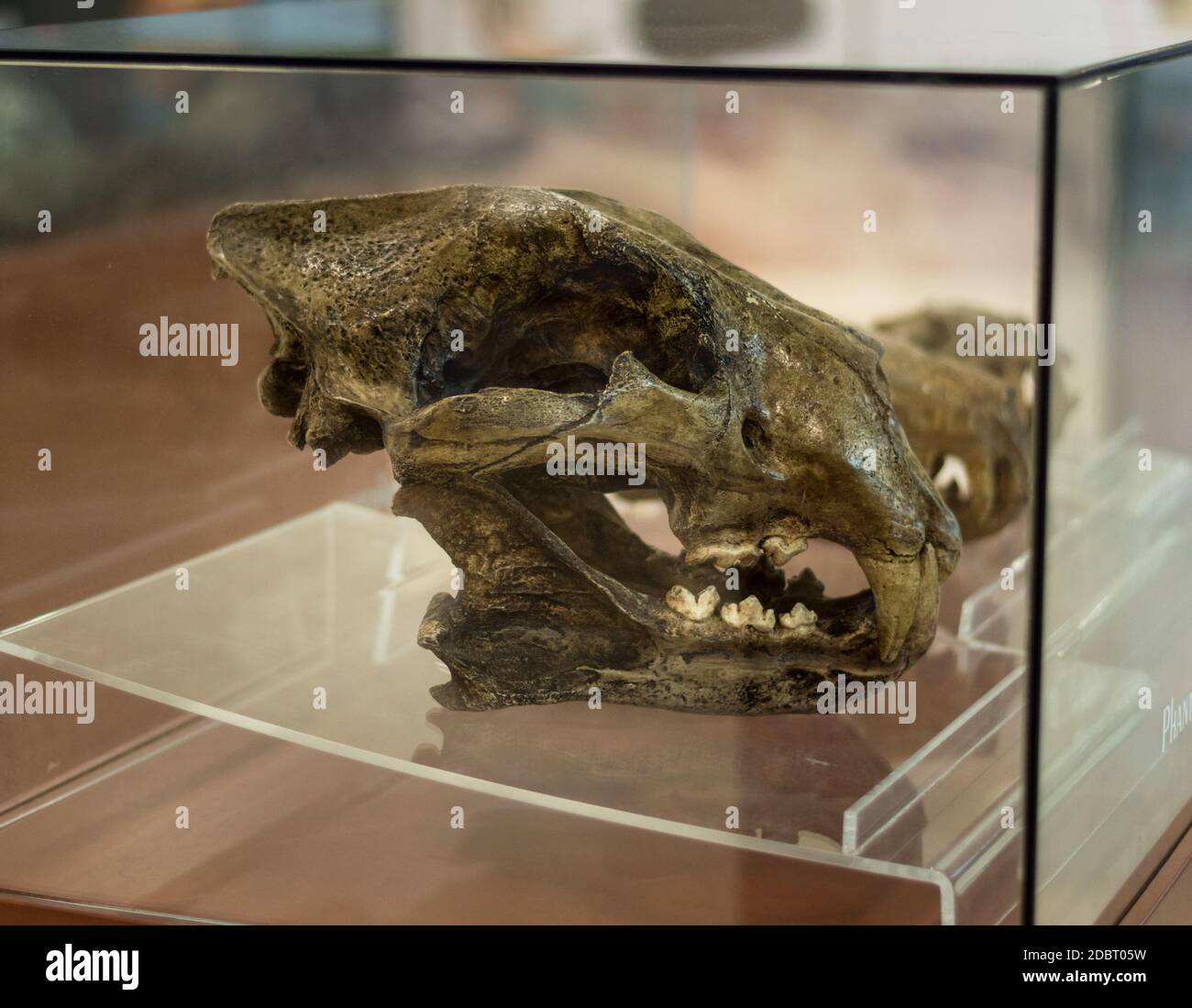 Panthera atrox fossil, North American Lion skull at the Crater museum of Chicxulub, Yucatan, Mexico. Stock Photohttps://www.alamy.com/image-license-details/?v=1https://www.alamy.com/panthera-atrox-fossil-north-american-lion-skull-at-the-crater-museum-of-chicxulub-yucatan-mexico-image385916325.html
Panthera atrox fossil, North American Lion skull at the Crater museum of Chicxulub, Yucatan, Mexico. Stock Photohttps://www.alamy.com/image-license-details/?v=1https://www.alamy.com/panthera-atrox-fossil-north-american-lion-skull-at-the-crater-museum-of-chicxulub-yucatan-mexico-image385916325.htmlRF2DBT05W–Panthera atrox fossil, North American Lion skull at the Crater museum of Chicxulub, Yucatan, Mexico.
 Panthera atrox fossil, North American Lion skull at the Crater museum of Chicxulub, Yucatan, Mexico. Stock Photohttps://www.alamy.com/image-license-details/?v=1https://www.alamy.com/panthera-atrox-fossil-north-american-lion-skull-at-the-crater-museum-of-chicxulub-yucatan-mexico-image385916255.html
Panthera atrox fossil, North American Lion skull at the Crater museum of Chicxulub, Yucatan, Mexico. Stock Photohttps://www.alamy.com/image-license-details/?v=1https://www.alamy.com/panthera-atrox-fossil-north-american-lion-skull-at-the-crater-museum-of-chicxulub-yucatan-mexico-image385916255.htmlRF2DBT03B–Panthera atrox fossil, North American Lion skull at the Crater museum of Chicxulub, Yucatan, Mexico.
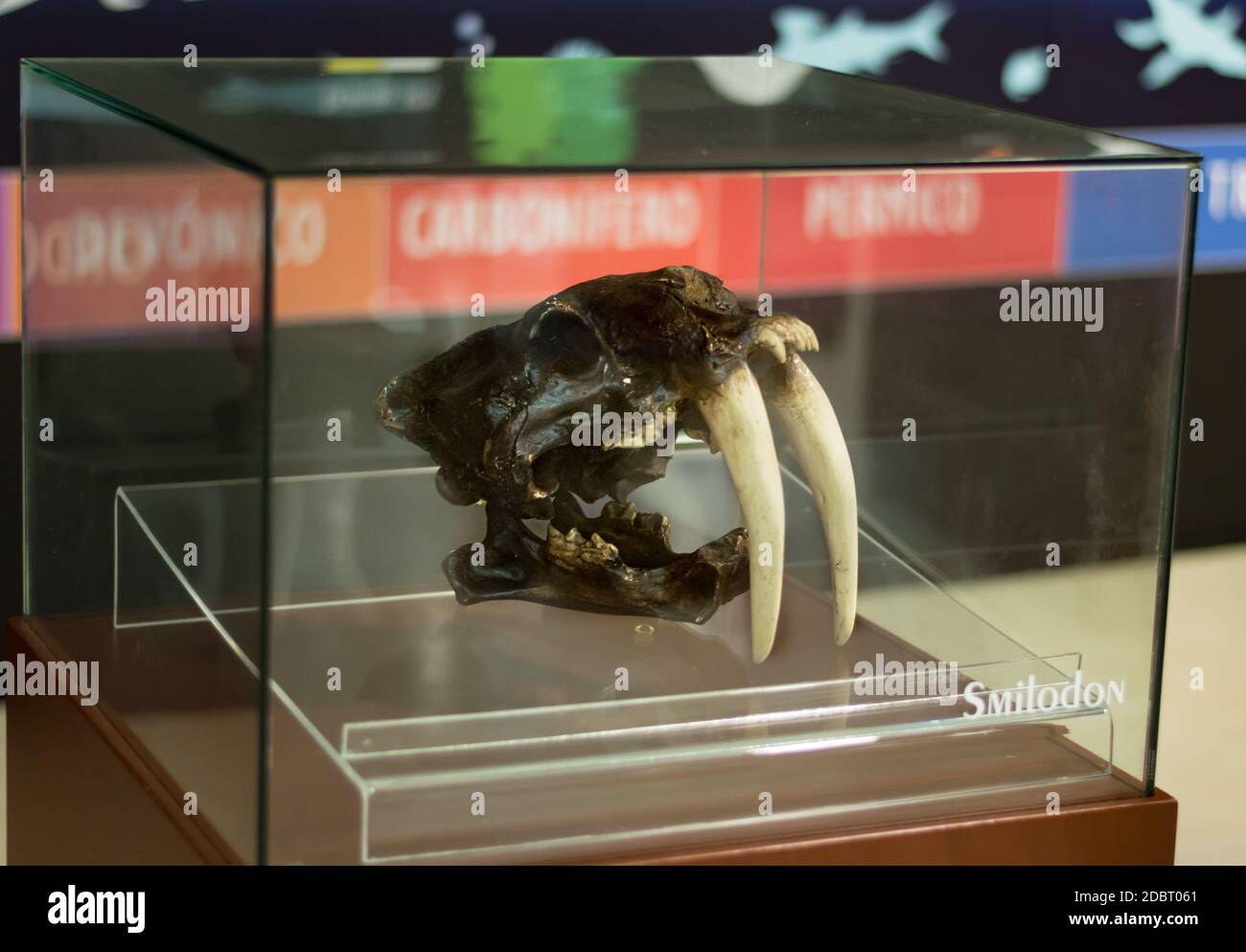 Saber-toothed cat, Smilodon skull, fossil in display at the crater museum in Yucatan, Mexico. Stock Photohttps://www.alamy.com/image-license-details/?v=1https://www.alamy.com/saber-toothed-cat-smilodon-skull-fossil-in-display-at-the-crater-museum-in-yucatan-mexico-image385916329.html
Saber-toothed cat, Smilodon skull, fossil in display at the crater museum in Yucatan, Mexico. Stock Photohttps://www.alamy.com/image-license-details/?v=1https://www.alamy.com/saber-toothed-cat-smilodon-skull-fossil-in-display-at-the-crater-museum-in-yucatan-mexico-image385916329.htmlRF2DBT061–Saber-toothed cat, Smilodon skull, fossil in display at the crater museum in Yucatan, Mexico.
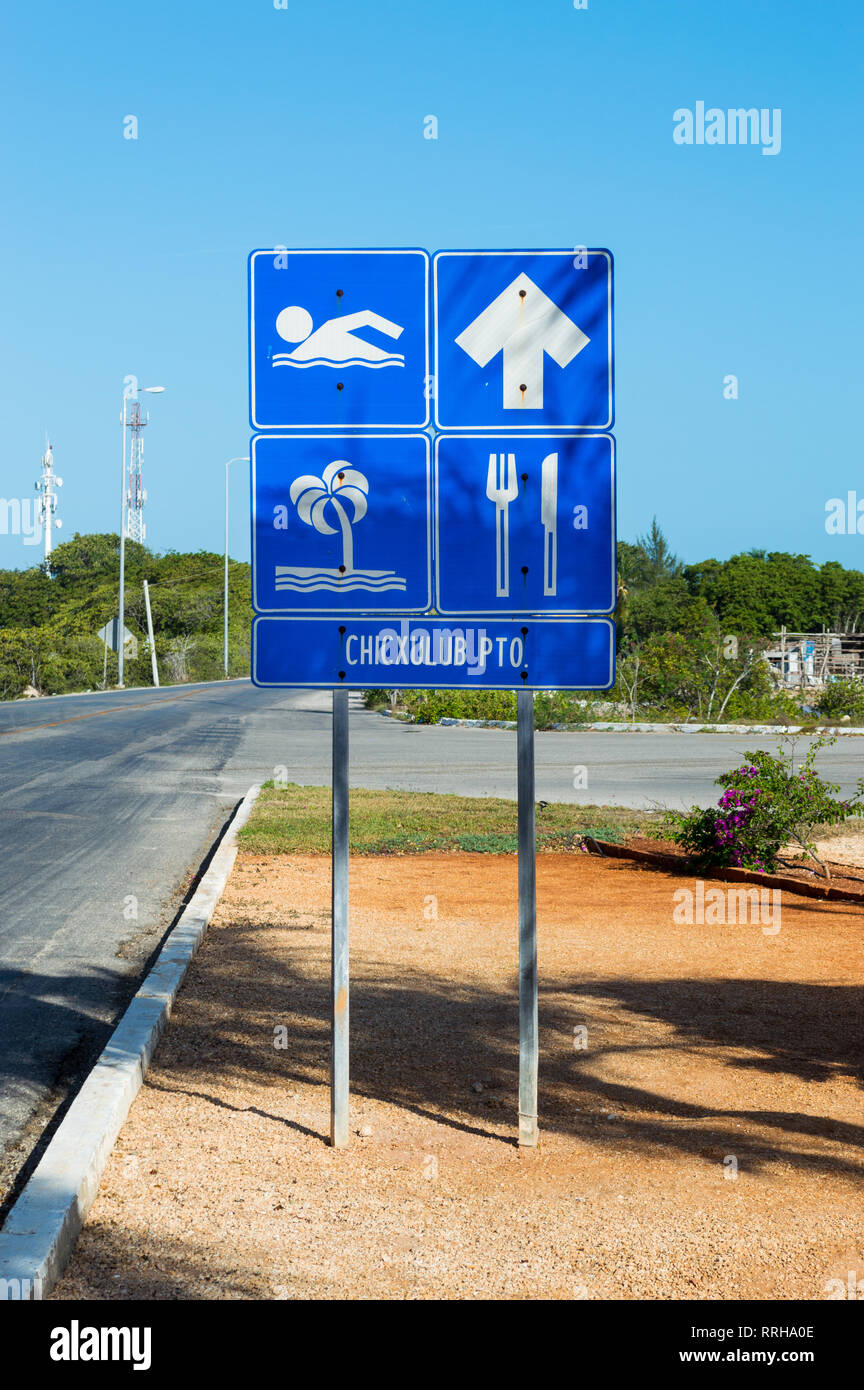 Chicxulub town sign in Yucatan, Mexico. Stock Photohttps://www.alamy.com/image-license-details/?v=1https://www.alamy.com/chicxulub-town-sign-in-yucatan-mexico-image238252910.html
Chicxulub town sign in Yucatan, Mexico. Stock Photohttps://www.alamy.com/image-license-details/?v=1https://www.alamy.com/chicxulub-town-sign-in-yucatan-mexico-image238252910.htmlRFRRHA0E–Chicxulub town sign in Yucatan, Mexico.
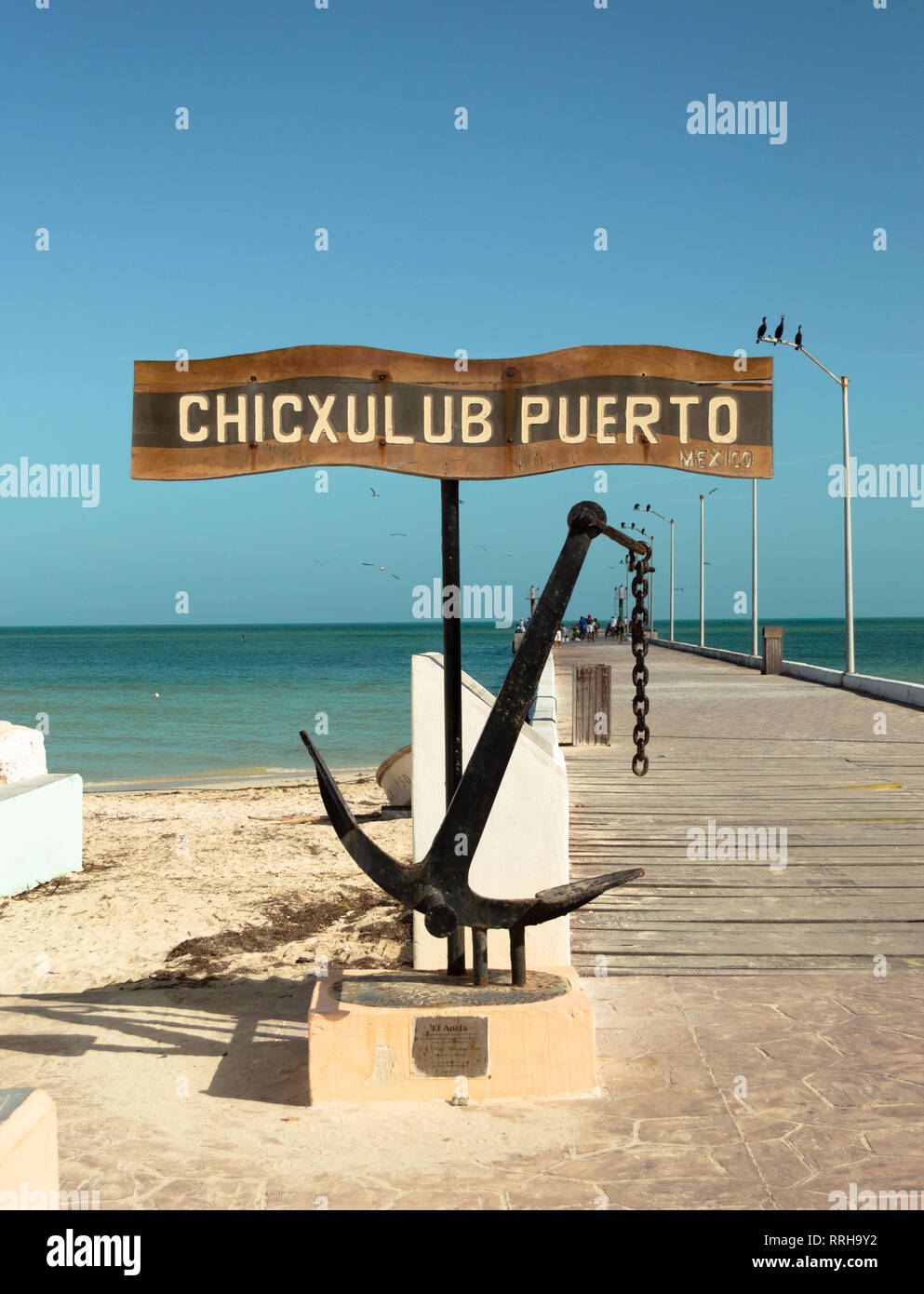 Chicxulub sign on the pier. Yucatan, Mexico. Stock Photohttps://www.alamy.com/image-license-details/?v=1https://www.alamy.com/chicxulub-sign-on-the-pier-yucatan-mexico-image238252870.html
Chicxulub sign on the pier. Yucatan, Mexico. Stock Photohttps://www.alamy.com/image-license-details/?v=1https://www.alamy.com/chicxulub-sign-on-the-pier-yucatan-mexico-image238252870.htmlRFRRH9Y2–Chicxulub sign on the pier. Yucatan, Mexico.
 Pollution on a Mangrove in Chicxulub, Yucatan, Mexico. Stock Photohttps://www.alamy.com/image-license-details/?v=1https://www.alamy.com/pollution-on-a-mangrove-in-chicxulub-yucatan-mexico-image238252889.html
Pollution on a Mangrove in Chicxulub, Yucatan, Mexico. Stock Photohttps://www.alamy.com/image-license-details/?v=1https://www.alamy.com/pollution-on-a-mangrove-in-chicxulub-yucatan-mexico-image238252889.htmlRFRRH9YN–Pollution on a Mangrove in Chicxulub, Yucatan, Mexico.
 Pollution on a Mangrove in Chicxulub, Yucatan, Mexico. Stock Photohttps://www.alamy.com/image-license-details/?v=1https://www.alamy.com/pollution-on-a-mangrove-in-chicxulub-yucatan-mexico-image238252894.html
Pollution on a Mangrove in Chicxulub, Yucatan, Mexico. Stock Photohttps://www.alamy.com/image-license-details/?v=1https://www.alamy.com/pollution-on-a-mangrove-in-chicxulub-yucatan-mexico-image238252894.htmlRFRRH9YX–Pollution on a Mangrove in Chicxulub, Yucatan, Mexico.
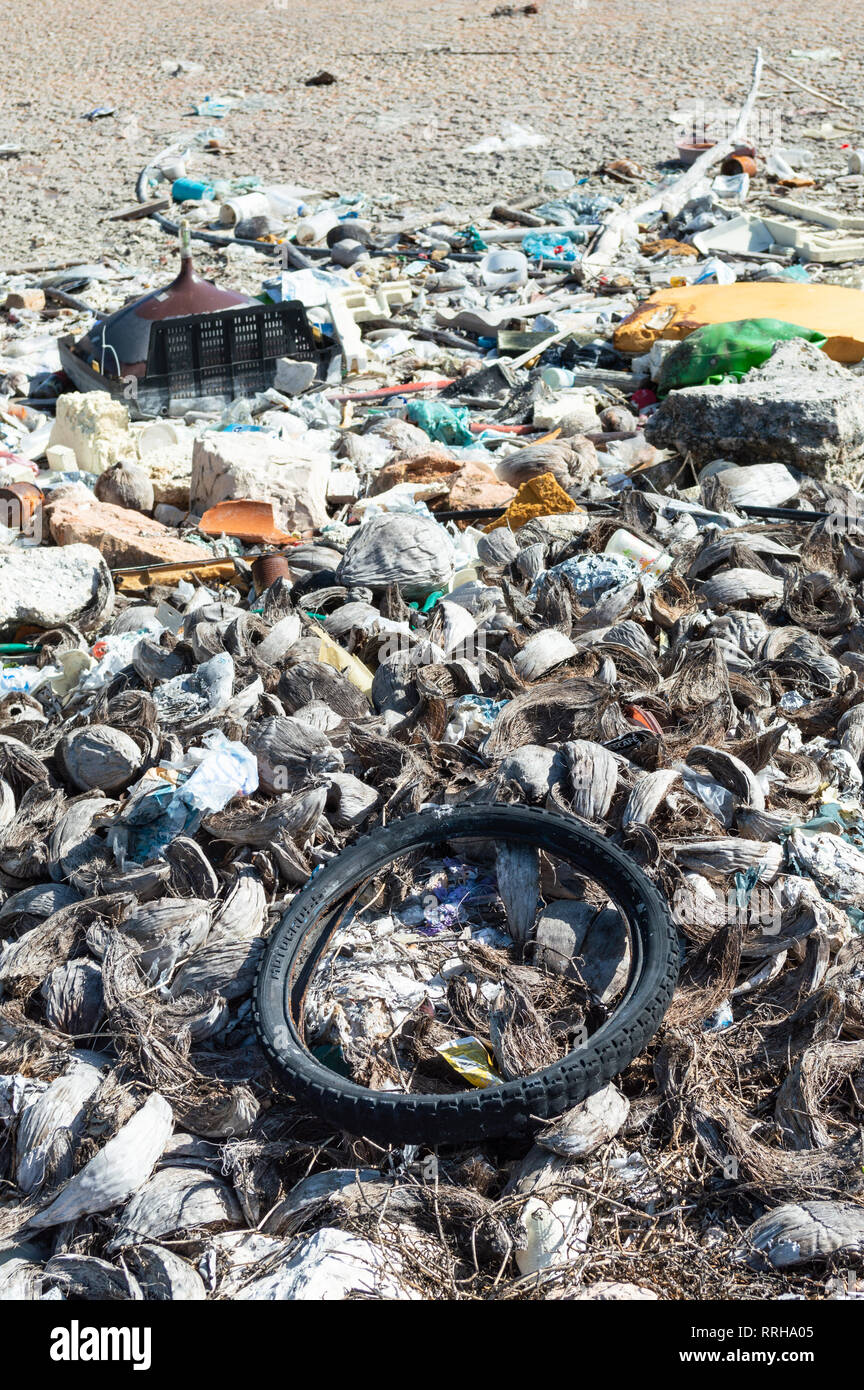 Pollution on a Mangrove in Chicxulub, Yucatan, Mexico. Stock Photohttps://www.alamy.com/image-license-details/?v=1https://www.alamy.com/pollution-on-a-mangrove-in-chicxulub-yucatan-mexico-image238252901.html
Pollution on a Mangrove in Chicxulub, Yucatan, Mexico. Stock Photohttps://www.alamy.com/image-license-details/?v=1https://www.alamy.com/pollution-on-a-mangrove-in-chicxulub-yucatan-mexico-image238252901.htmlRFRRHA05–Pollution on a Mangrove in Chicxulub, Yucatan, Mexico.
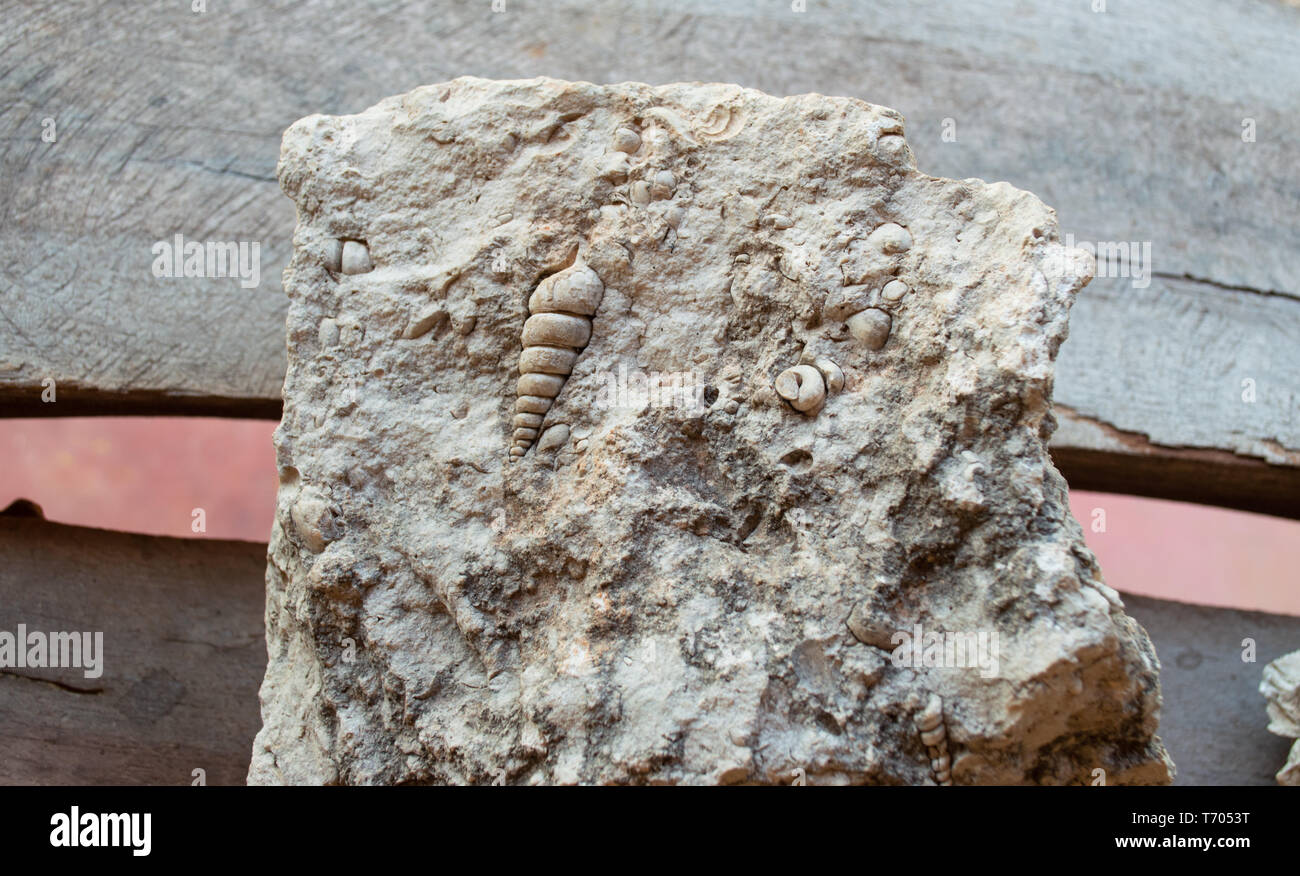 10,000 ocean fossil on limestone, found in Campeche, Mexico. Stock Photohttps://www.alamy.com/image-license-details/?v=1https://www.alamy.com/10000-ocean-fossil-on-limestone-found-in-campeche-mexico-image245251772.html
10,000 ocean fossil on limestone, found in Campeche, Mexico. Stock Photohttps://www.alamy.com/image-license-details/?v=1https://www.alamy.com/10000-ocean-fossil-on-limestone-found-in-campeche-mexico-image245251772.htmlRFT7053T–10,000 ocean fossil on limestone, found in Campeche, Mexico.

